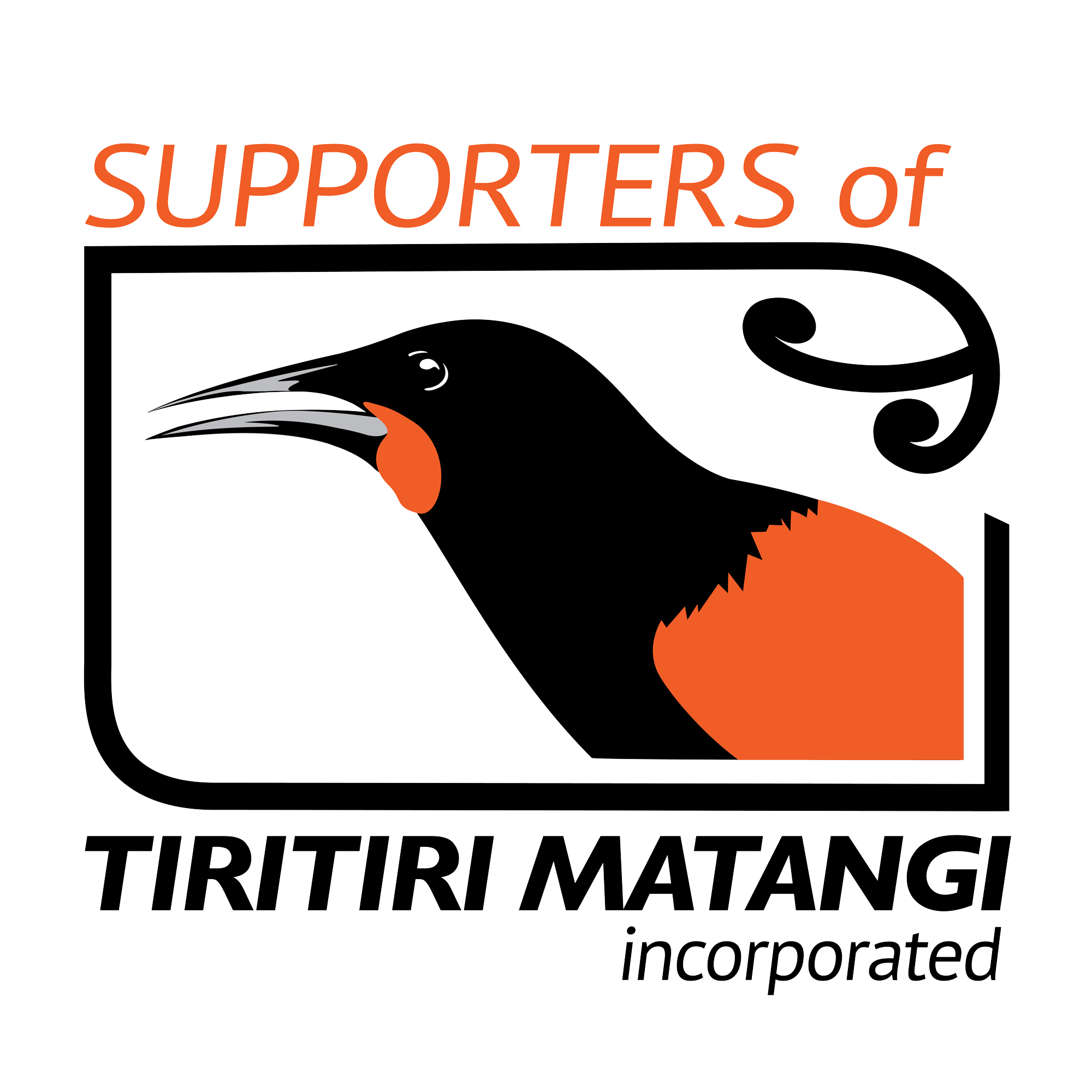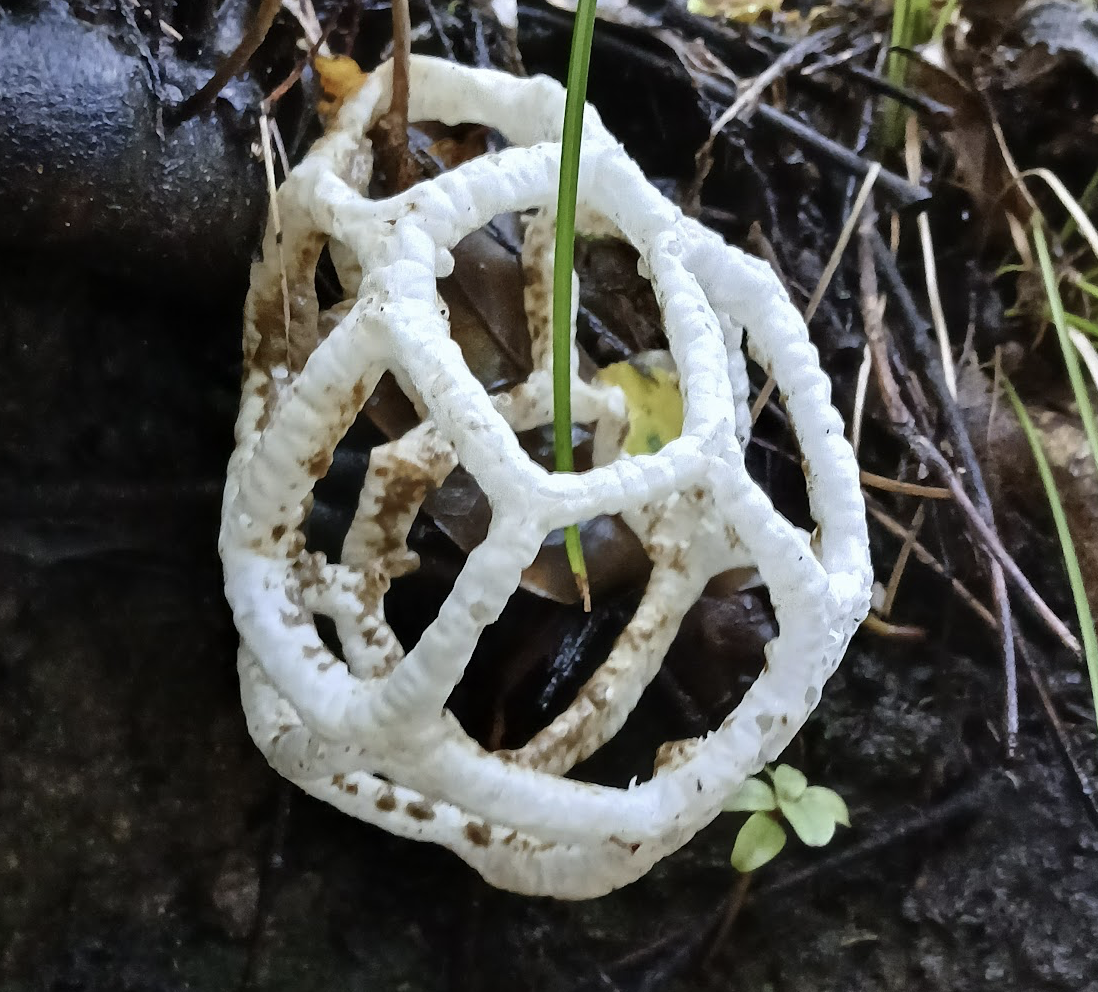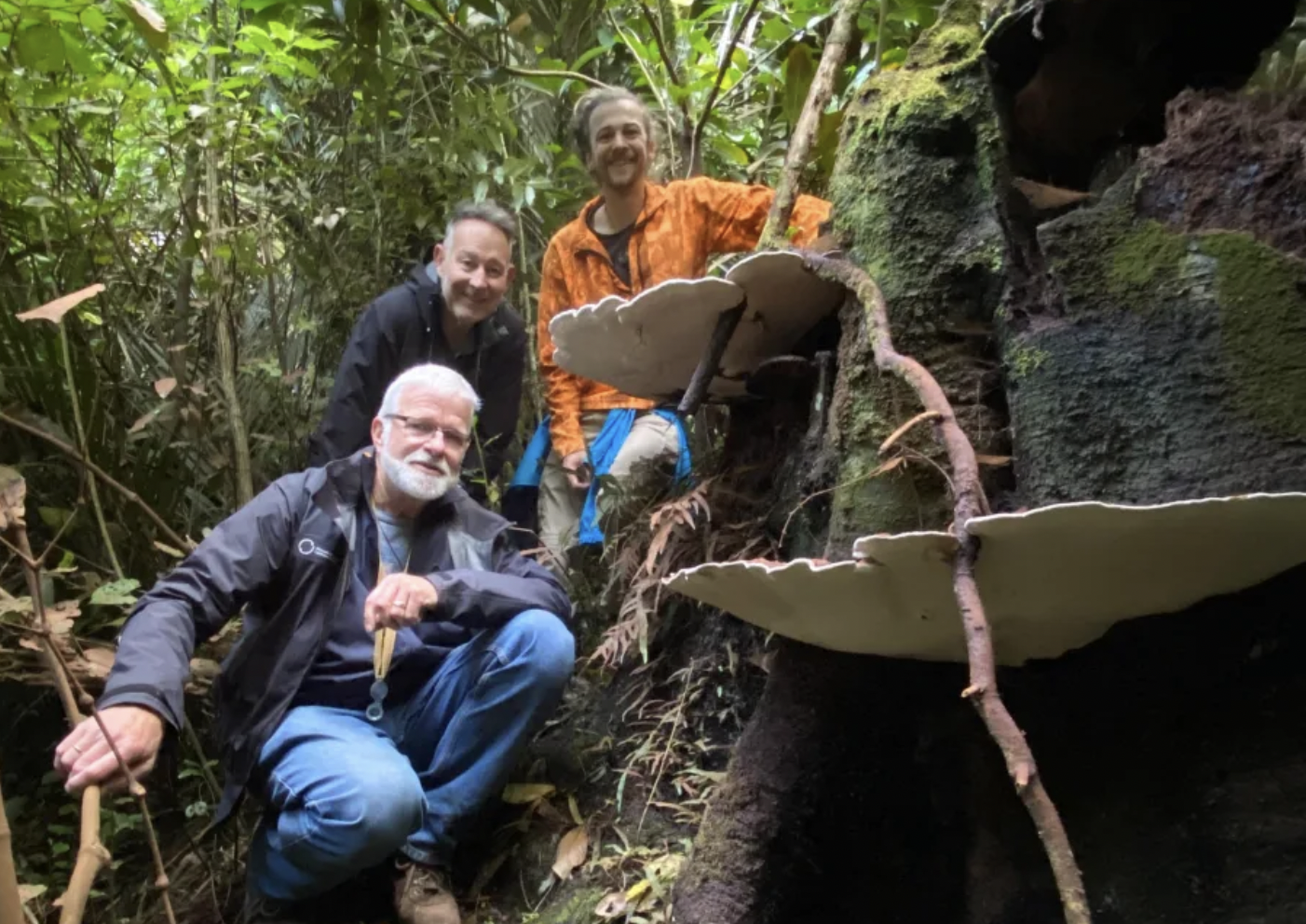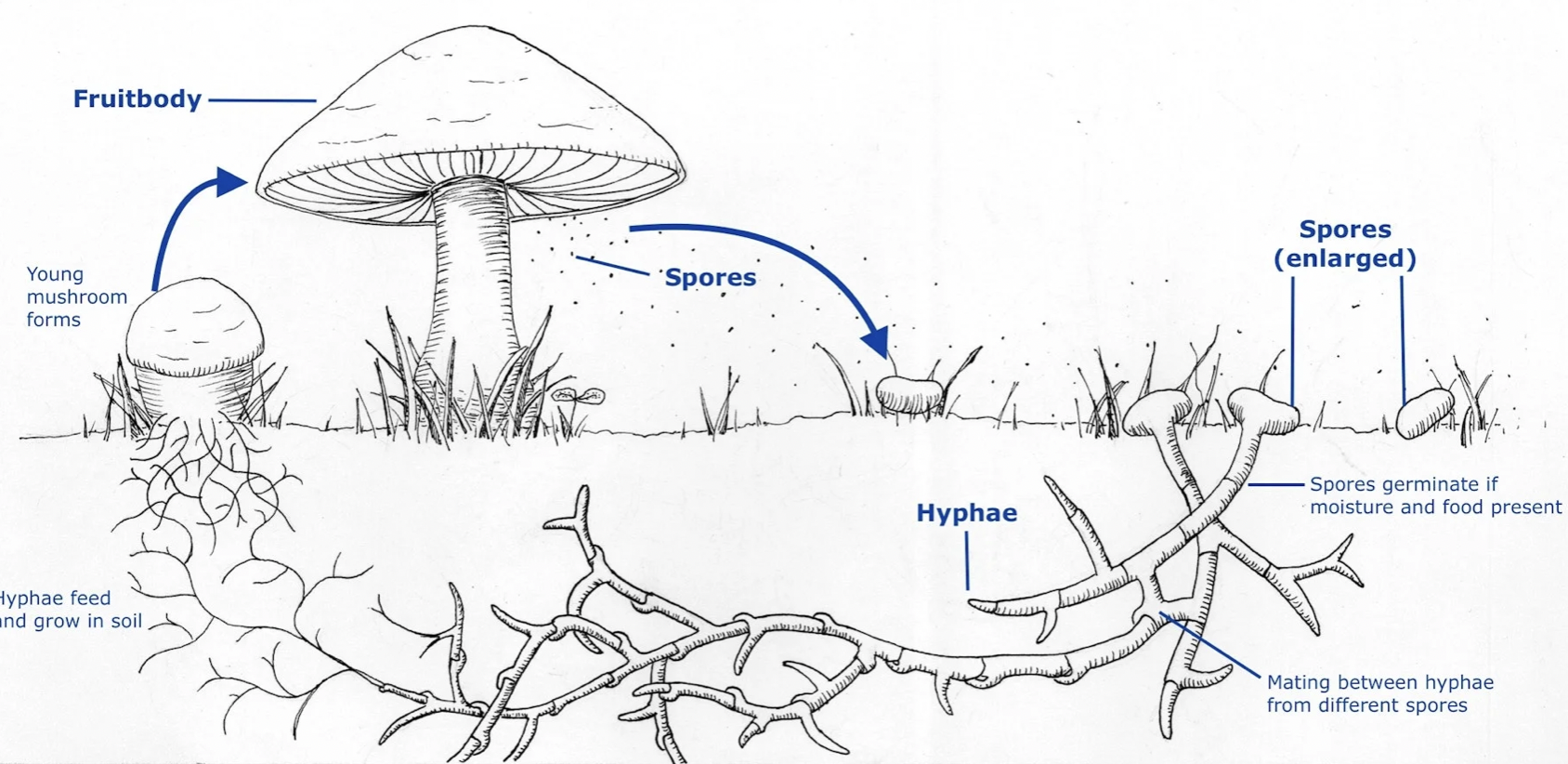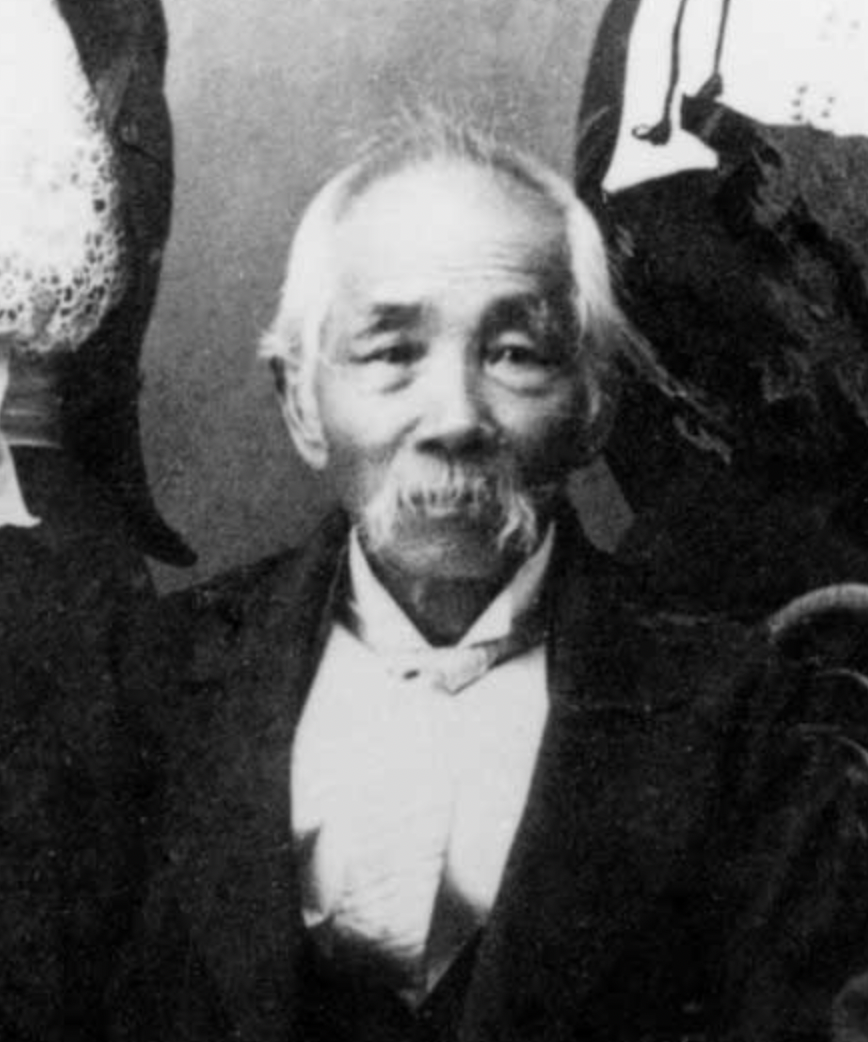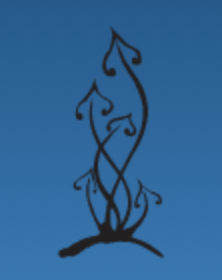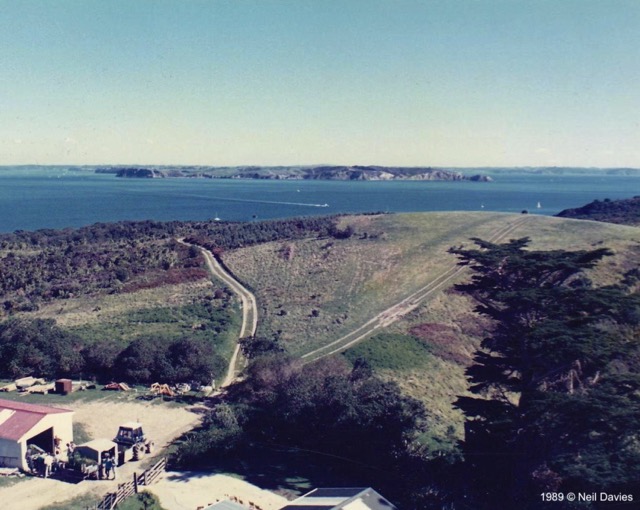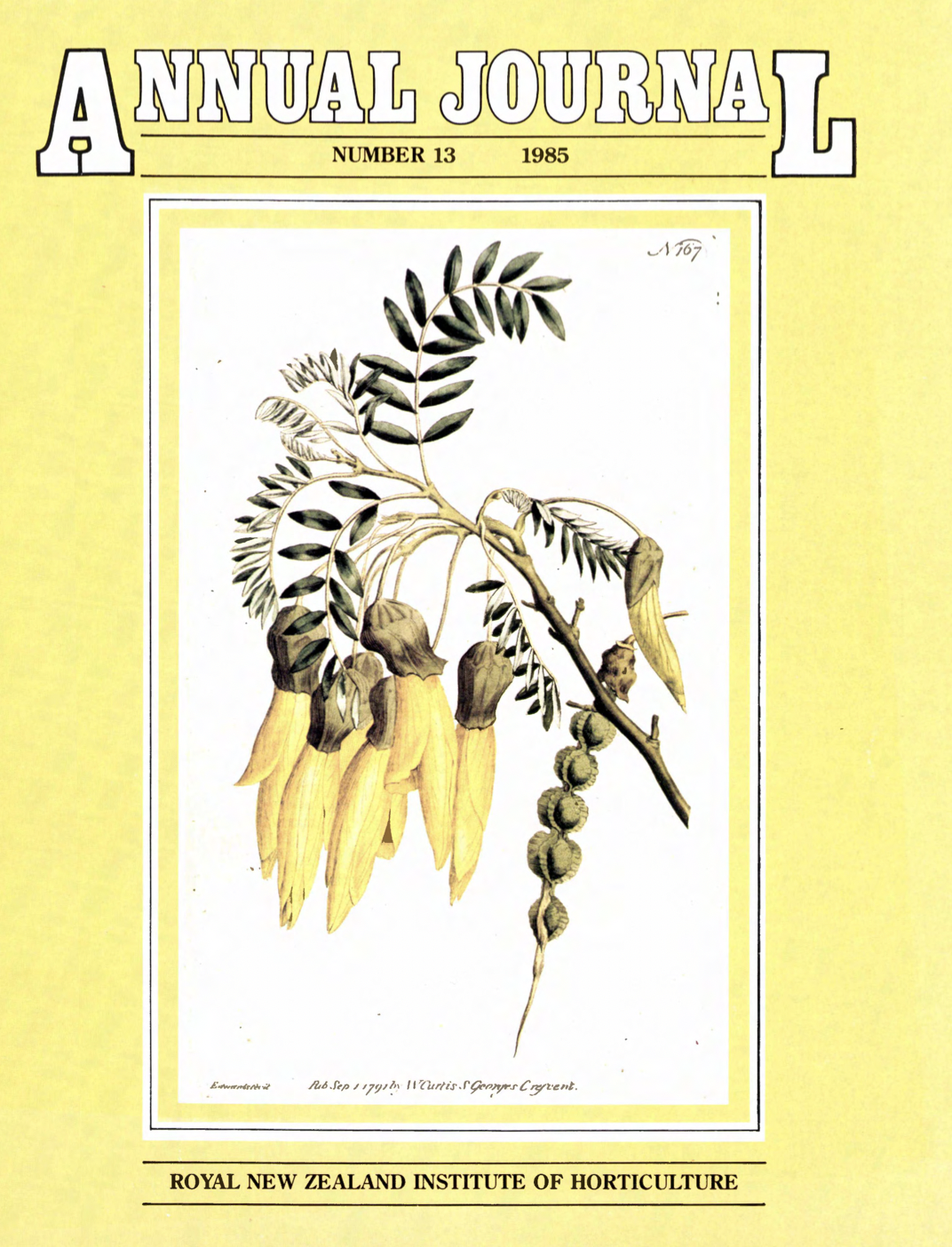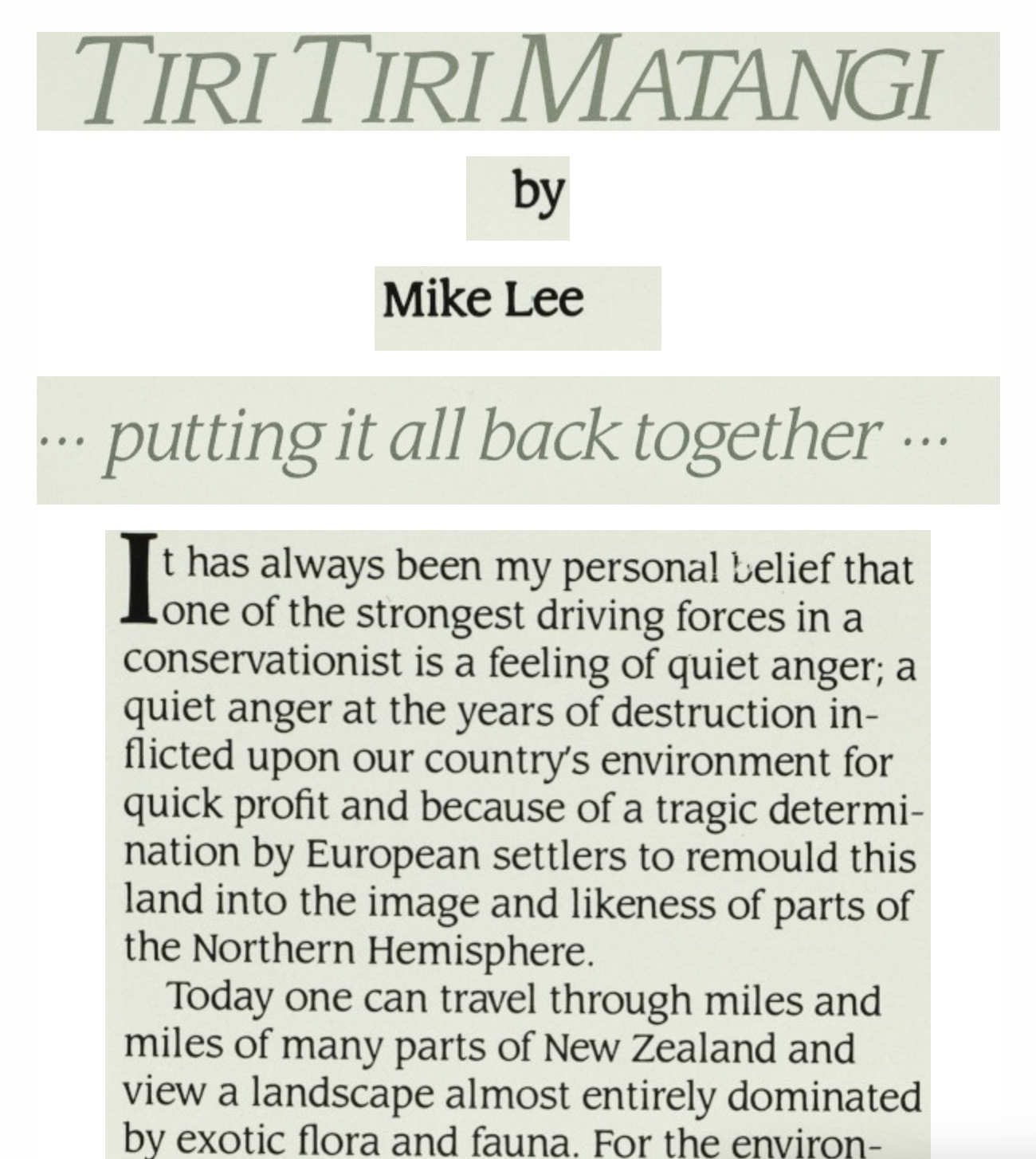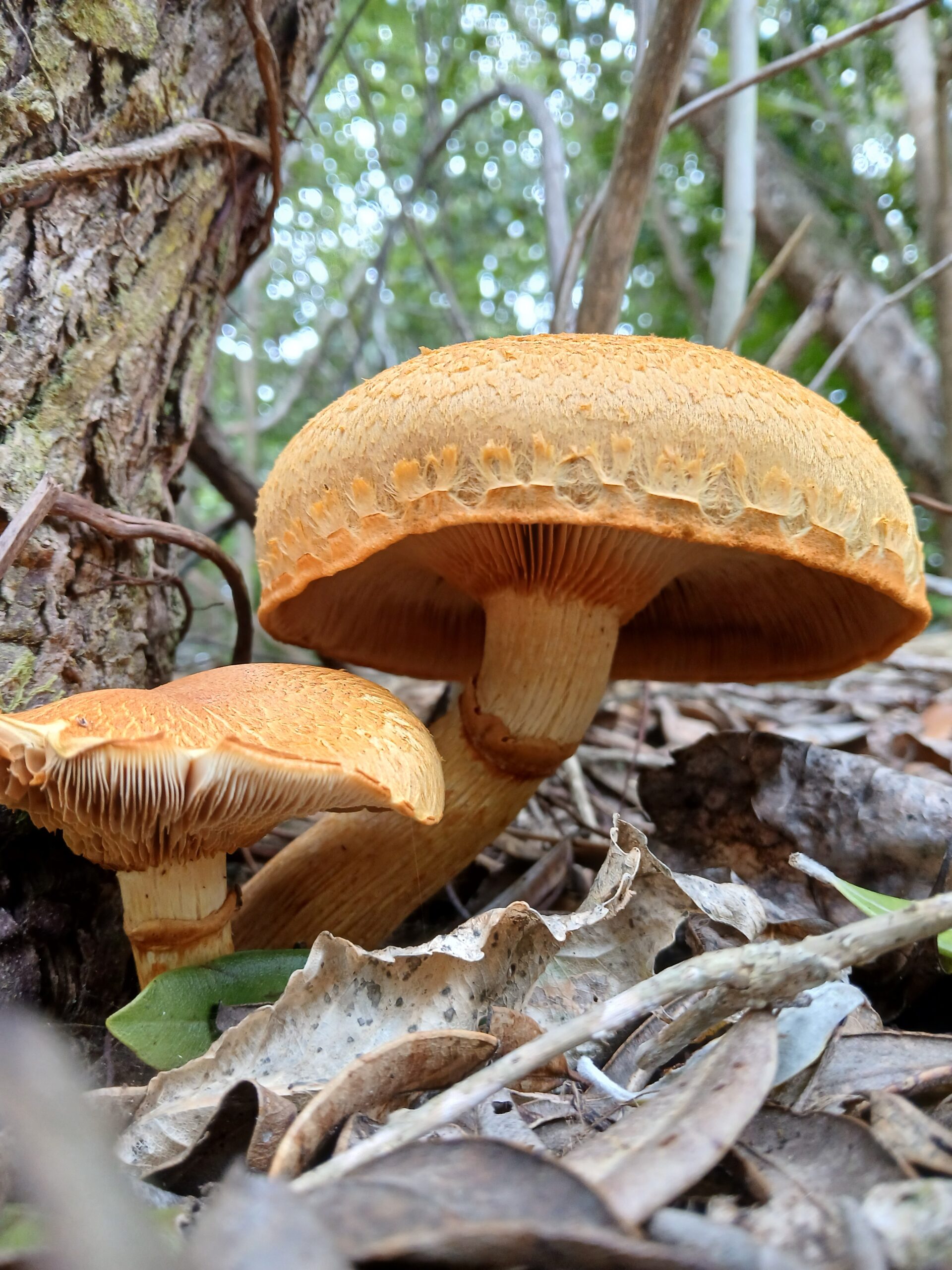Nature’s Carbon Catchers: How Pōhutukawa Trees Help Our Planet
Nature’s Carbon Catchers: How Pōhutukawa Trees Help Our Planet
Nature’s Carbon Catchers: How Pōhutukawa Trees Help Our Planet
Author: Stacey Balich, volunteer guide
Photo credit: Pōhutukawa photos, Jonathan Mower
Did you know that big old trees like the pōhutukawa are working quietly every day to keep our planet healthy? These trees are more than just beautiful, they’re nature’s carbon catchers.
When trees grow, they absorb a gas from the air called carbon dioxide (CO₂). This gas is made up of carbon, a natural building block found in all living things, people, animals, and plants included. When trees grow, they soak up carbon from the air and use it to build their trunk, branches, and leaves. This is called being a carbon sink, it’s like the tree is a sponge, soaking up extra carbon! This helps keep the Earth cooler, because too much carbon in the air can make the planet warmer than it should be. So, trees aren’t just growing, they’re helping cool the planet.
And there’s more! As trees take in carbon dioxide, they also release oxygen, which we all need to breathe. That means every tree is helping us in two big ways: by cleaning the air and by giving us the oxygen we need to live.

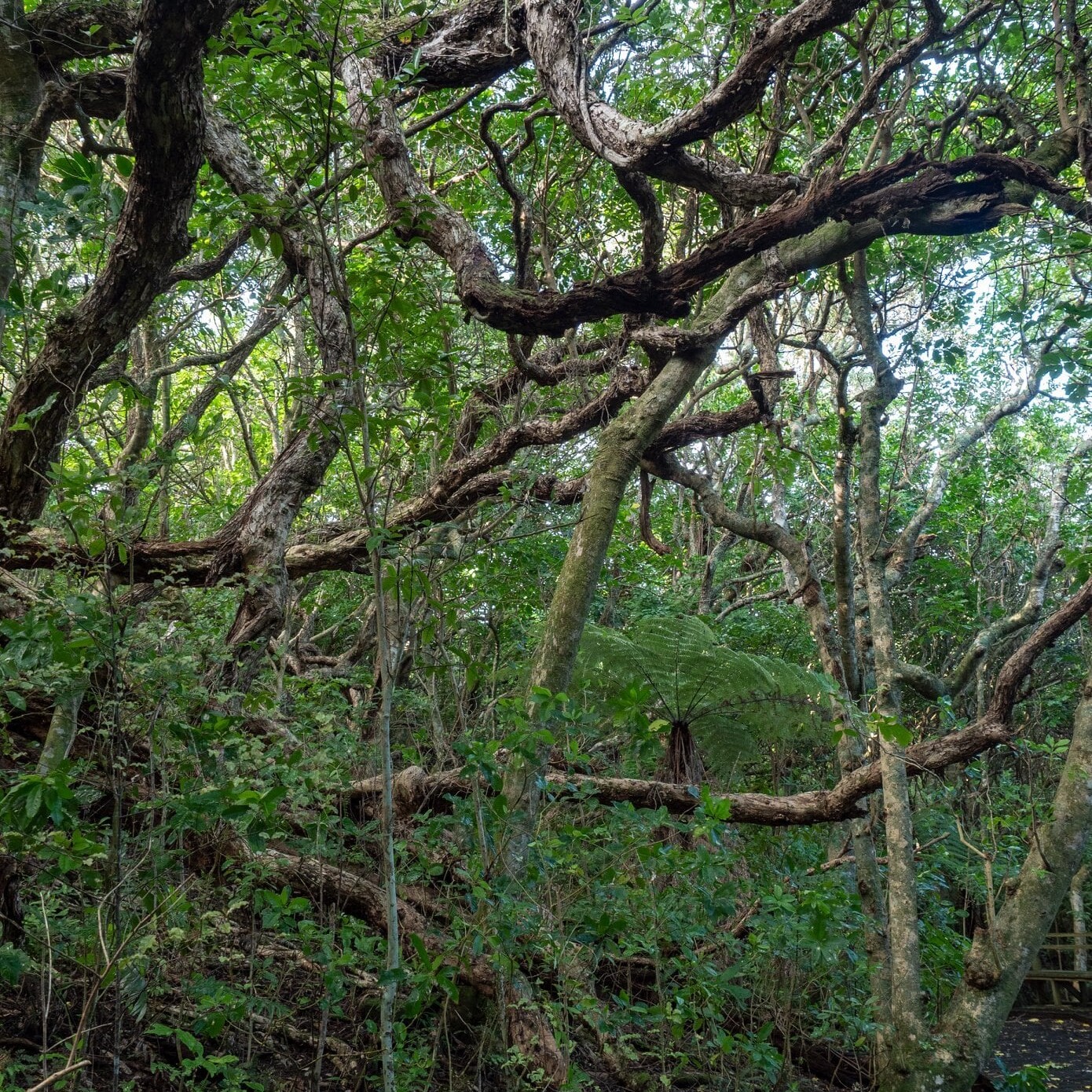
This incredible pōhutukawa has stood through centuries of change, regenerating itself after falling, and now grows in a graceful curve along a hillside spur.
One special pōhutukawa tree on Tiritiri Matangi Island, nestled beside the Kawaura Track, is estimated to be over 1,000 years old. This incredible tree has stood through centuries of change, regenerating itself after falling, and now grows in a graceful curve along a hillside spur. It’s a living link to the original coastal forest that once covered the island, long before people arrived in Aotearoa.
This ancient Metrosideros excelsa is more than just a tree, it’s a powerful symbol of resilience, renewal, and natural history. But it’s also a climate hero. A mature pōhutukawa can store up to 8 tonnes of carbon dioxide in its lifetime, that’s like stopping a car from driving the entire length of New Zealand from Cape Reinga to Bluff and back more than ten times!

Tiritiri Matangi’s forest restoration is another amazing story. In the 1980s, volunteers planted around 280,000 native trees to bring the island’s forest back to life. These trees have absorbed roughly 280,000 tonnes of carbon dioxide—that’s equivalent to the carbon emissions from heating and powering around 30,000 average New Zealand homes for a year!
We do our part to keep Tiritiri sustainable, too. We use solar panels for power, rainwater tanks for water, and e-bikes to get around the island. While we still need to bring over some fuel for the ute and LUV, we’re working to reduce that by using the e-bikes more and more.

Around 300 million years ago, Earth’s oxygen levels were much higher, about 35%, compared to today’s 21%. During this period, some insects grew enormous, with dragonflies reaching the size of seagulls! Higher oxygen made it easier for insects to grow large because they absorb oxygen directly through their skin. Today, Earth’s atmosphere contains just the right amount of oxygen for life as we know it, too little, and breathing becomes impossible; too much, and it could cause harm. Just like carbon dioxide, balance is key. Nature does an amazing job of maintaining this balance, and it’s up to us to help keep it steady.
Three Easy Ways You Can Help
- Walk, bike, or catch the bus instead of using the car all the time—it puts less carbon into the air.
- Turn off lights and electronics when you’re not using them to save energy.
- Plant trees and care for nature—trees soak up carbon and keep the air fresh and clean. Support or volunteer in local restoration projects like the one on Tiritiri Matangi
- Grow some of your own food – even herbs in pots reduce transport emissions.
Every time we protect trees, care for forests, and choose lower-carbon ways of living, we’re helping our planet stay cooler, cleaner, and healthier for the future. Just like the ancient pōhutukawa on Tiritiri Matangi, we all have a role to play.
The Sometimes Missing ‘F’ Word: Fauna, Flora, and Funga
The Sometimes Missing ‘F’ Word: Fauna, Flora, and Funga
Written by Stacey Balich, based on the Tiritiri Talk presented by speaker Peter Buchanan.
We were thrilled to welcome Peter Buchanan from Manaaki Whenua, Landcare Research as the guest speaker for this season’s Tiritiri Matangi Talk. His engaging presentation, “The Sometimes Missing ‘F’ Word: Fauna, Flora, and Funga,” opened our eyes to the often-overlooked world of fungi and its essential role in our ecosystems. Around 80 people gathered to hear Peter’s fascinating insights, making it one of our most well-attended and thought-provoking talks to date.
Peter opened with a surprising revelation: the largest biological kingdom on Earth isn’t flora or fauna—it’s fungi. In biology, a kingdom is one of the highest levels of classification, grouping together all forms of life with shared fundamental traits. Fauna (animals) ranks first, funga (fungi) second, and flora (plants) comes in third, challenging the way many of us think about the natural world and its major players. He explained that fungi are so abundant and ecologically important that, in April 2024, National Geographic officially adopted the term “funga,” giving fungi equal footing with flora and fauna in biodiversity conversations.
He went on to explain the powerful role of symbiotic fungi, particularly in native forests of beech, mānuka, and kānuka. These fungi form mutually beneficial partnerships with plants, helping them absorb water and nutrients through vast underground networks called mycelium. The fungi, in turn, feed on carbohydrates provided by the plants or from decomposing leaves. These thread-like fungal cells, called hyphae, spread out through the soil, massively increasing the area that plant roots can access, making the forest floor a complex web of interdependence and nutrient exchange.
Peter also discussed lichens, which are not a single organism but a partnership between fungi and algae. The fungal structure provides a framework, while the green algae component captures sunlight to create energy. Without the fungi, the lichen wouldn’t exist, it’s this partnership that allows them to thrive in harsh and nutrient-poor environments.
He reminded us that the mushroom we see above ground is just the fruiting body, its purpose is to produce and release spores, much like a tree flowering to make seeds. The majority of fungus lives below the surface as mycelium, working constantly to break down organic material and sustain forest health.
The talk also touched on parasitic fungi, such as myrtle rust, which arrived in New Zealand from Australia in 2017. It has caused widespread damage to native myrtle species like pōhutukawa, ramarama, and mānuka. Peter also noted Armillaria, a native fungus that causes root rot and affects commercial crops like kiwifruit. These are examples of pathogenic fungi, those that cause disease.
In contrast, saprobic fungi play a vital role in decomposing organic material and cycling nutrients back into the forest. However, Peter cautioned that artificially adding mulch to forest environments can disrupt these natural cycles, as mulch may attract non-native fungal species and change the native balance.
A highlight of Peter’s talk was a remarkable photograph he took during the 2025 New Zealand Fungal Foray at Rotokare, near Eltham. It featured a gigantic Ganoderma bracket fungus, 82 cm wide and 45 cm thick, estimated to be around 30 years old. Even after decades of research, Peter admitted he’d never seen one so large. The discovery was a vivid reminder of how quietly and powerfully fungi shape our landscapes over time.
Peter highlighted the astonishing fungal diversity in Aotearoa. For every one species of vascular plant, there may be up to six fungal species, meaning there are likely tens of thousands of fungi in New Zealand, many yet to be formally described.
He also honoured mātauranga Māori, traditional Māori knowledge of fungi. He shared that:
- Te pūtewa, a bracket fungus, was used as tinder and for wound care.
- Te pekepekekiore, ear-like fungi, were used as food.
- Te matakupenga, the net-like basket fungus, could be eaten in its early “egg” form.
- Te Āwheta, a parasitic fungus, was used to create black pigment for tā moko (traditional tattooing), when mixed with charcoal and bird fat.
- Cyttaria, a parasitic fungus on southern beech, is a seasonal food for kererū.
Another significant species is te hakeke, or wood ear fungus (Auricularia), nicknamed “Taranaki wool.” It holds the distinction of being the only native mushroom commercially exported, thanks to Chinese merchant Chew Chong, who collected and exported it between 1875 and 1885. There is a fantastic museum in Taranaki, Tawhiti, that tells this story in more detail.
Peter also broke down the lifecycle of a mushroom:
- Spore dispersal – Mushrooms release spores into the environment.
- Germination – Spores develop into hyphae.
- Mycelium formation – Hyphae fuse and grow into a mycelial network.
- Fruiting – The mycelium produces mushrooms above ground.
- Spore release – The cycle begins again.
He added that fungi reproduce sexually when compatible hyphae (like male and female types) meet and exchange genetic material, further revealing how complex and life-like fungal systems can be.
A particularly heartwarming moment came when Peter shared how he had contributed feedback to the Reserve Bank during the redesign of the $50 note. In the earlier design, te werewere kōkako, a stunning blue fungus, was partially obscured. Thanks to his advocacy, it now features prominently. He also shared the beautiful Māori kōrero that the kōkako bird’s distinctive blue wattles came from brushing against this blue fungus while feeding, tying together the bird and the fungus in name, legend, and colour.
To conclude, Peter highlighted why conserving fungi is essential for ecosystem health. Today, 45 New Zealand fungi are assessed by the IUCN Red List, and nine are listed as endangered. These include:
- Calostoma fuscum (Fischer’s egg),
- Ganoderma, the pukatea bracket fungus, last seen in 1972,
- and Hypocreopsis amplectens—the critically endangered “tea tree fingers.”
Peter closed with a look at New Zealand’s two major fungal collections:
- The New Zealand Fungi Herbarium in St Johns, holds over 110,000 dried specimens, many kept frozen, with data freely accessible to the public.
- The International Collection of Microorganisms from Plants (ICMP), which contains 11,000 living fungal cultures, supports both science and conservation.
Peter’s talk was a powerful reminder that fungi are not just background players in nature, they’re architects of ecosystems, keepers of culture, and unsung heroes of biodiversity.
To find out more, click on the images below.
How WWF Sparked New Zealand’s Open Sanctuary
How WWF Sparked New Zealand’s Open Sanctuary
This narrative is compiled with reference to Anne Rimmer’s detailed account in her book, Tiritiri Matangi: A Model of Conservation.
In 1982, Sir Peter Scott, son of legendary Antarctic explorer Captain Robert Falcon Scott, was in New Zealand scouting potential conservation projects for the World Wildlife Fund. A visit to Tiritiri Matangi Island, arranged by his friend Ronald Lockley and accompanied by conservationists John Craig, Neil Mitchell, and Graeme Turbott, sparked his imagination. As they sailed to the island aboard MY Bondi Belle, Scott saw more than just windswept paddocks, he saw possibility. It was Scott who first coined the now widely used term “open sanctuary” to describe Tiritiri Matangi: a predator-free haven accessible to all.
Motivated by Scott’s vision, the World Wildlife Fund adopted Tiritiri Matangi as a flagship project. Under Scott’s direction, WWF formed a fundraising committee, and over $40,000 was raised by public subscription. With a two-to-one government subsidy, the fund grew to nearly $150,000, an impressive sum for the time. This allowed the project to move from drawing board to reality. Landscape architect Mike Cole, alongside Tiritiri’s first park ranger and last lighthouse keeper, Ray Walter, began the hard graft of ecological restoration.
In 1983, a large shadehouse complex was completed, and Cole and Walter began germinating seeds collected from the island’s remnant native bush. Unlike much of the surrounding region, Tiritiri lacked kauri and was instead suited to a rich mix of northern broadleaf coastal species; pōhutukawa, kohekohe, pūriri, karaka, and taraire. In total, 29 species were propagated, including six from Te Hauturu-o-Toi/Little Barrier Island, chosen specifically to provide vital nectar and berries for the future population of hihi/stitchbirds.
By autumn 1984, over 30,000 young trees stood ready in root-trainers. But the question loomed: how would they all be planted? It became clear the project’s success would rely on long-term voluntary labour, an approach never before attempted at such a scale in New Zealand. At the same time, Ray Walter’s role on the island was coming to an end, with the automation of the lighthouse set to make his job redundant. But from this uncertain period emerged a new opportunity. The Tiritiri Matangi project needed someone to live full-time on the island, someone capable, self-sufficient, and familiar with its rhythms. Ray, already deeply connected to Tiritiri and skilled in hands-on island living, was the perfect fit.
Encouraged by Neil Mitchell, who told him, “If you can grow cabbages, you can grow trees” Ray officially took charge in 1985. Under his steady guidance, and with the support of thousands of volunteer hands, Tiritiri Matangi was slowly transformed from open paddocks into a thriving forest—its story a lasting testament to vision, resilience, and collective effort.
To find out more about Tiritiri Matangi history why not buy Tiritiri Matangi: A Model in Conservation by Anne Rimmer
Please click on the images below to read old documents for more information
Ferns, Fungi, and Forest Magic
Ferns, Fungi, and Forest Magic
Ferns, Fungi, and Forest Magic
Author: Stacey Balich, volunteer guide
Tiritiri Matangi is one of those rare places where you can truly switch off, and I mean really switch off. There’s no Wi-Fi and barely any phone reception, so your mobile pretty much turns into just a camera. And honestly? That’s kind ofthe point. The island moves at a slower pace, and you do too. You breathe deeper, walk slower, and notice all the little things you usually miss in the rush of everyday life.
Winter might just be the best time to visit. The sugar feeders are buzzing with life, hihi/stitchbirds and korimako/bellbirds darting in and out, filling the air with this incredible, layered birdsong that somehow manages to be both chaotic and calming. Just find a bench nearby, sit still, and listen. You might spot a tūī hanging around, trying to sneak a sip of sugar water, though they’re way too big to get in. It’s kind of cheeky and charming all at once. And when you really stop and let yourself tune in, it’s wild how much you hear.
If you’re up for a walk, my go-to is the Kawerau Track. It weaves through some of the island’s oldest forest, where the trees are tall, the light filters in soft and green, and the forest feels… grounded. The track kind of invites you to slow right down and just be. No rush. No noise. Just birds, trees, and that gentle hush that only old forests seem to have.
Winter’s also peak fungi season, and yes, I get way too excited about that. The forest floor becomes a treasure hunt (my favourite kind), dotted with tiny pops of colour and weird, wonderful shapes. Bright orange caps, little inky fans, coral-like clusters growing out of moss and bark. They’re not just pretty either, fungi are these underground powerhouses, breaking down dead stuff and returning nutrients to the soil. Total decomposition superheroes. They even help store carbon in the soil, doing their bit to keep forests resilient in our ever-changing climate.
Further along the trail, there’s a little stream. If you’re lucky (and patient), you might spot a kokopu gliding through the water, almost ghost-like. Everything here feels ancient, like the forest is holding old stories and every now and then, it tells you one.
And don’t forget to look up. The tree ferns are quietly doing their thing, with their fronds slowly unfurling in perfect spirals. I always pause to check the crooks of the trunks, sometimes, just sometimes, you’ll see a sleepy ruru/morepork tucked into the ferny shade. Spotting one always feels like a tiny bit of magic.
Right now, the kohekohe are flowering. It always surprises me, these small, delicate blooms sprouting straight out of thick tree trunks. There’s something so beautiful about that contrast. And the birds clearly agree, you can hear them hopping between blossoms, taking full advantage of the nectar buffet.
Every time I come here, I’m reminded that this island exists because people had a dream, and they made it happen. Walking under those old pōhutukawa trees, seeing the fresh green fronds beside their gnarled branches, it feels like nature’s way of saying thank you. Like the old and the new are growing side by side.
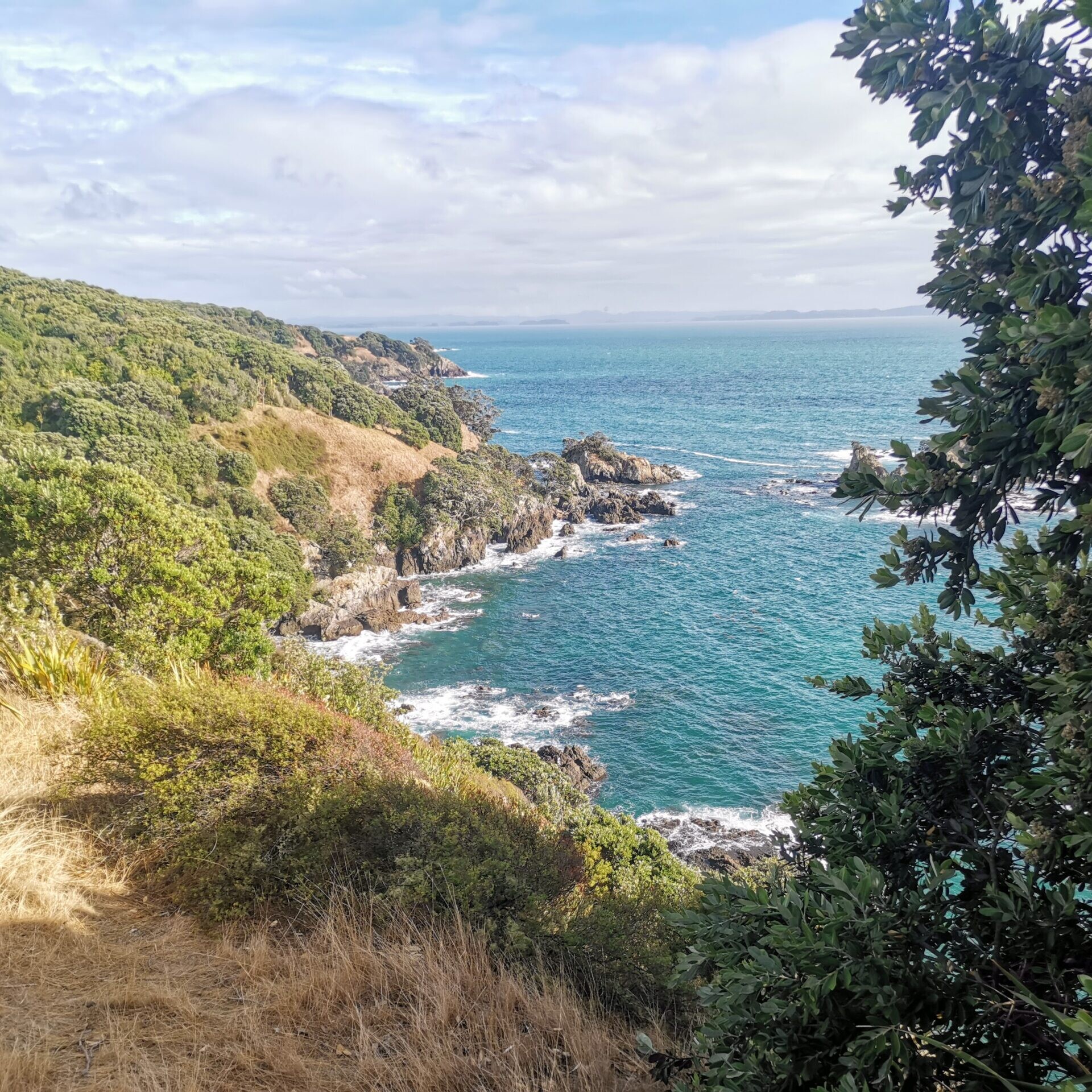
Views along the east coast
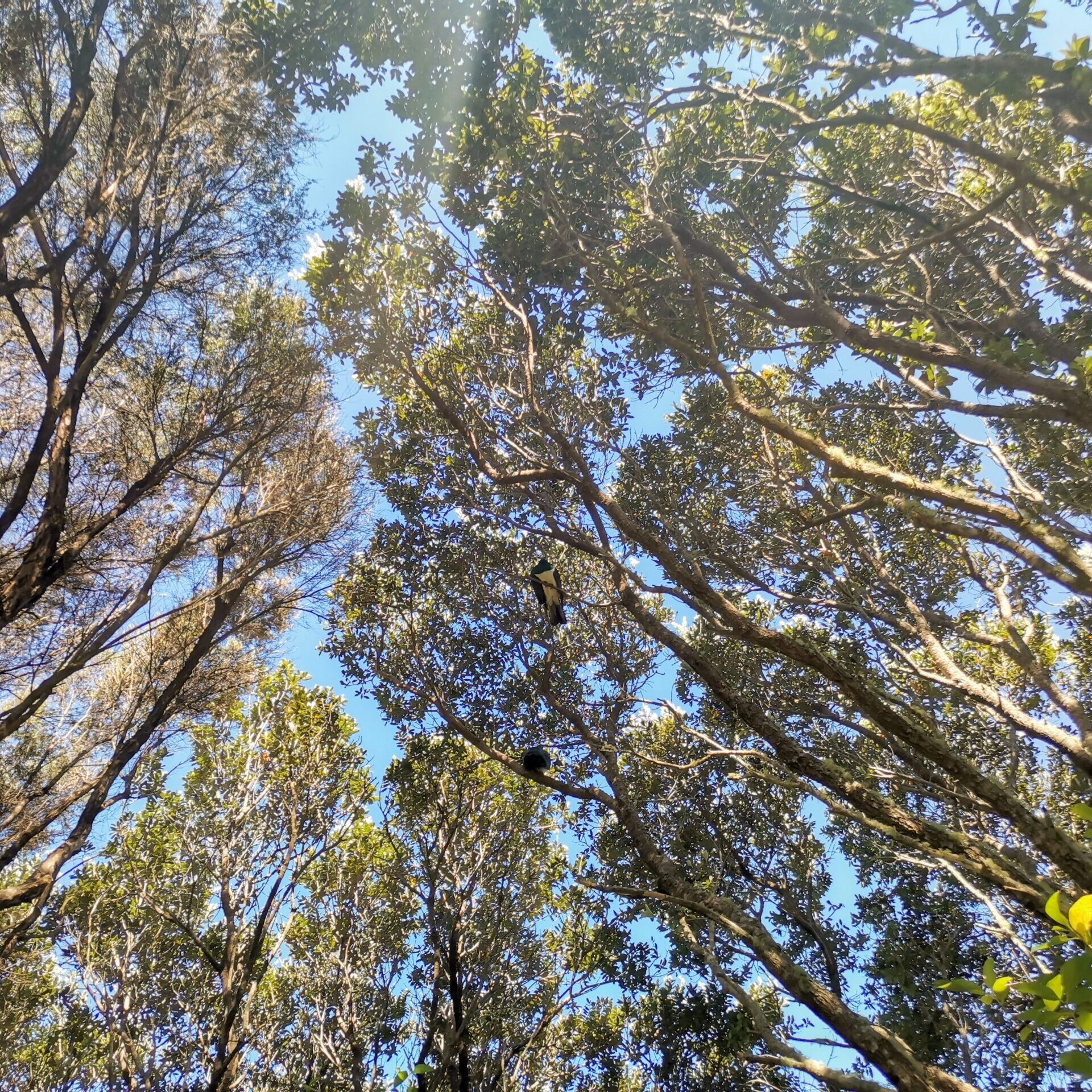
Looking up

A busy decomposing superhero

My favourite bird, the takahē
If you’ve got the time, I really recommend cutting across Fishermans Bay Track when you’re up on Ridge Road. The walk along the coastline up to the lighthouse gives you these incredible views, with dramatic cliff edges that feel totally different from the bushy side of the island. It’s also where I’ve been lucky enough to hear the call of the mātātā/fernbird and spot flashes of bright green kākāriki darting through the shrubs. It’s a bit quieter out that way too, which makes those special wildlife moments even better.
My absolute favourite bird on the island has to be the takahē. Every time I see one, it fills up my inner bird bucket, there’s just something about them. The way they walk is so deliberate and a bit clumsy, it’s hard not to smile. And their feathers? Iridescent blues and greens that catch the light like a living jewel. There’s a pair that often hang out near the lighthouse and another pair that sometimes up the north end of the island, so keep your eyes peeled, you’ll never forget the moment you spot one.
So if you’re feeling a bit frazzled or just tired of scrolling—come over for the day. Leave your phone on airplane mode and listen to the birds instead. Take a deep breath. Wander a trail. And let Tiritiri Matangi remind you how to slow down and just be again.

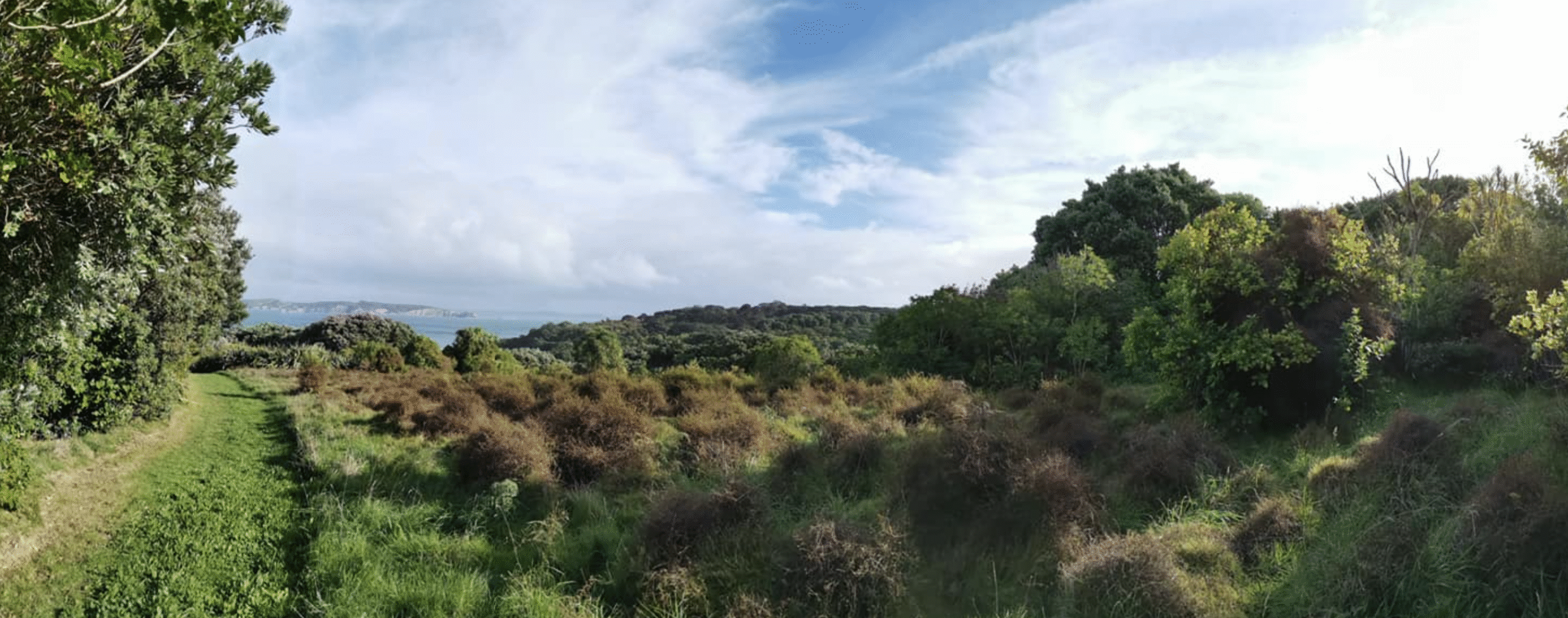
Inspiring environmental action in our school
From Tiritiri Matangi to Ōtāhuhu:
Inspiring environmental action in our school
From Tiritiri Matangi to Ōtāhuhu:
Author: Josh Burrowes, Associate Principal at Ōtāhuhu Primary, shares the school's journey of environmental learning with Dawn Chorus.
From the Supporters of Tiritiri Matangi Archives: Bulletin 139, November 2024
Ōtāhuhu Primary School has been undergoing a shift in our approach to inquiry learning over the past two years.
Last year, we made a plan to investigate the “three B’s” in our school environment – birds, bugs and bees – to understand biodiversity and the relationship between our physical environment and its impact on how the three B’s survive. Given the industrial nature of our school’s surrounding neighbourhood, we wanted to ensure that our students are exposed to a rich and biodiverse ecosystem so that they can better understand these concepts.
We were connected with Tiritiri Matangi and applied for the Growing Minds Programme, which has allowed us to see our vision come to life. Throughout 2024, with the support of the funding we received through Growing Minds, we have been able to take almost all of our Year 4-6 students across to Tiritiri Matangi Island (almost 300 students) to experience this once-in-a-lifetime opportunity.
The journey began during the Term 1 school break when we took our teachers across to Tiritiri Matangi to get firsthand experience on the island, with guided walks from some of the island’s educators. This was an amazing opportunity for our teachers to find their feet and understand all of the learning that can take place on the island, as well as understand the demands of taking large groups of students across. Growing Minds provided us with additional resources to make this trip achievable, which we were very thankful for. This pre-visit was incredibly important for our teachers to gain the confidence they needed to undertake this experience. We highly recommend that any new schools looking at going to Tiritiri Matangi take this step as well.
Over Term 2, we had planned to take 13 classes to the island in all. Most made it without trouble, some trips were postponed due to high winds and storms, and one trip got as far as Gulf Harbour before having to turn back due to much worse than anticipated sea conditions. This was an unfortunate experience for those two classes as they battled large waves, a rocky boat, and a lot of upset stomachs. Their trip has been rescheduled, but a nervous wait looms for those children and their parents.
For the trips that have gone ahead, all we can say is that we are so glad we took the risk and put months of planning into making them happen. These experiences have been invaluable not only for our students, who have made incredible connections to their learning experiences in school, but for the whānau that have come along as well. As you can imagine, this has been a very popular experience for our community, and we have done what we can as a school to get as many people across to the island as possible. Our principal has shown great leadership and commitment to the programme, ensuring that no one misses out, despite the costs involved. We know that we are fortunate to be able to visit Tiritiri Matangi Island, and many of our students and their families will not get this opportunity again. It is worth it!
Our teachers and students have been inspired by what they have seen. Tiritiri Matangi is so full of life, and to know that within our lifetimes (at least for many of our teaching staff) it was a farm riddled with rats and other pests, that has been transformed into this brilliant sanctuary, it gives us hope as to how we can impact our local environment. Our students now have the challenge of taking some of the magic they experienced on Tiritiri Matangi and putting it into practice as they apply their new knowledge back in Ōtāhuhu. Gardens, tree planting, constructing bee sanctuaries, and bug hotels are all ideas coming to life as we take action this term at school.
We are so grateful for the support we have received from Growing Minds. The educators and volunteers at Tiritiri Matangi have also been incredible on every trip. This is an experience that every Auckland student should get to experience at some point in their lives, particularly with all that we face in our changing climate, and we hope that more opportunities will be created in the future.
From everyone at Otāhuhu Primary, we say THANK YOU to everyone who contributes their time, knowledge and resources to these programmes.
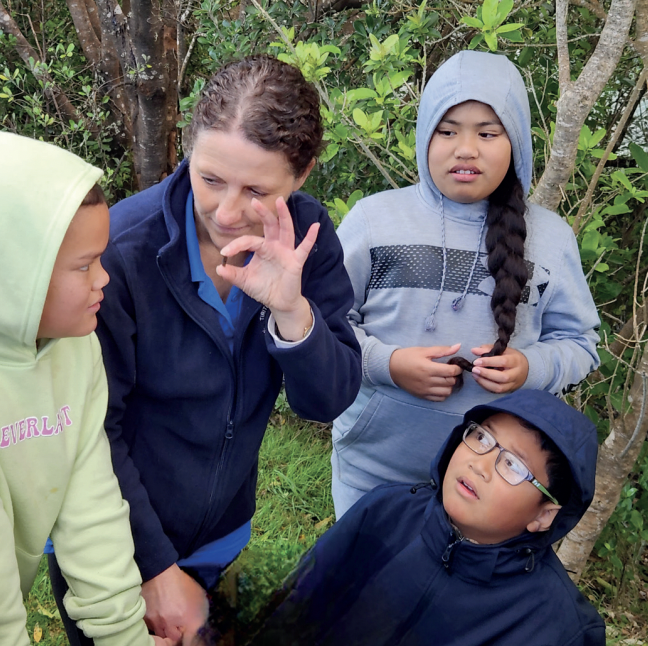
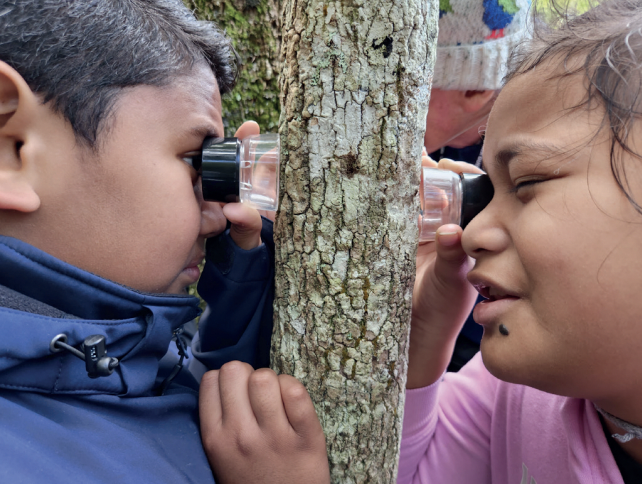
Sara Dean, lead educator shares:
“I’m looking at the bird with a blue chin” – The moment a boy from Otahuhu Primary became enthralled by the wonder of the kōkako. While his classmates enjoyed lunch in the courtyard, I noticed the boy standing alone, his gaze fixed intently. I asked him what he was doing. “I’m looking at the bird with the blue chin,” he replied. Dave was completely captivated by the kōkako feeding on a coprosma just a couple of meters away, oblivious to everything else around him. The experience was incredibly special to him, being so close to such a beautiful bird and even more so when he learnt how rare and endangered it is. Later in the afternoon, he shared his excitement with his classmates, recounting the story of how he had spotted the beautiful, rare bird and had a unique moment with it, undistracted by anything else. It was a touching scene, clearly a transformative experience for this young student.
Tiritiri Matangi’s island ‘classroom’ offers school students a powerful opportunity to explore ecological processes, understand the impact of human activity on the environment, and discover the richness of Aotearoa New Zealand’s unique biodiversity.
Our education programme delivers a range of hands-on, experiential learning experiences on the motu. By engaging with the outcomes of this successful community-led restoration project, students are inspired to become kaitiakitanga in their own local environments.
We believe every student in Auckland deserves the chance to experience Tiritiri Matangi. Thanks to the generous support of the Joyce Fisher Charitable Trust, the Growing Minds programme was launched in 2012. This initiative continues to break down socio-economic barriers, enabling thousands of students to experience conservation in action and learn first-hand about our native and threatened species. Growing Minds covers the cost of ferry travel with Explore and provides access to our education programme free of charge.


“None of this would have been possible without the Growing Minds Programme. Their commitment to enriching educational experiences has opened doors for our students, empowering them to make a positive impact on their community and the world.”
Christ the King School teacher
“Students reported feeling inspired by the conservation work happening on Tiritiri Matangi and have proposed a number of project ideas for our kura to follow in the footsteps of the motu and its incredible volunteers.”
Ardmore teacher
“The trip itself was nothing short of extraordinary. Tiritiri Matangi provided our students with a unique environment to explore and learn about New Zealand’s rich biodiversity. The educational activities organized on the island, including guided walks and interactive learning sessions about plants, trees, and wildlife, were both engaging and informative. I want to extend our heartfelt appreciation to all those involved for their unwavering support and commitment to providing such a great experience. The impact of this trip on our students’ learning and appreciation for the natural world cannot be overstated.”
Nathalie Irvine, Everglade Primary School
Student Feedback
“It was nice to have places to experience a sanctuary firsthand. I got the feel for nature and why we need to protect it. When you experience it, it makes you want to protect it.”
“I learnt about the power of community and perseverance, and also about the importance of translocation for preserving New Zealand’s biodiversity.”
“I will start doing the same things that the staff did in the island because I want my place to be more clean like an island.”
“The highlight of the day was the people that made our day so much more special and memorable. Of course the knowledge we learned from them, the history and the theory of Tiritiri Island.”
Visitor Centre Opening Springs Surprise
Visitor Centre Opening Springs Surprise
Visitor Centre Opening Springs Surprise
From the Supporters of Tiritiri Matangi Archives: Dawn Chorus, December 2005, Bulletin 63
Photo credit: Janet Petricevich
The official opening of Tiritiri Matangi lsland’s new Visitor Centre was attended by more than 100 Supporters and friends in early November. As Ray and Barbara unveiled the plaque, they were surprised to discover that the centre was named in their honour – The Ray and Barbara Walter Visitor Centre.
To the delight of everyone at the official opening of the new Visitor Centre on Tiritiri Matangi, Department of Conservation Rangers Ray and Barbara Walter, were unaware that the Visitor Centre was to be named after them.
As they pulled the cords to reveal the overhead plaque, their surprise was met with warm applause from the crowd.
Speakers and a dedication from Supporters’ founder Jim Battersby, preceded the unveiling and the cutting of a red ribbon by Ray and Barbara. First of the invited guides to speak was the Minister of Conservation Chris Carter, who retains the Conservation portfolio for a second term. He reflected on the Visitor Centre as part of the commitment to the importance of conservation education for present and future generations. “Tiritiri is an international icon for restoration conservation, and at international conservation events I often talk about what has been accomplished on Tiritiri. And about what can be achieved with a dedicated group of individuals working with the Department of Conservation to transform an island.
The Visitor Centre was important for both education and conservation, showing how natural ecosystems can be restored to support our unique biodiversity, he said.
The new Auckland Conservator for DoC, Sean Goddard, said he had visited Tiritiri 15 years ago and could not help but be inspired by what he saw on Tiritiri. “l’m astounded by the changes that have happened since then, in the canopy, and in the sights and sounds on the island. I hope that all of Auckland will become aware of the special places on their doorstep, such as the islands of the Hauraki Gulf.
“Tiritiri is very special among those special places. It is a beacon, and a model and inspiration for our conservation work in the Auckland region. The Visitor Centre was an important milestone, and a premier site for the interpretation of the stories of our threatened species, he said. “Stories that are all the more meaningful when we can see and hear them. These include stories of both our natural heritage and our historical heritage, including all the people that lived and worked on Tiritiri, both Māori and European stories,” said Mr Goddard. “l would like to finish with a proverb: ‘He kura taiao e hokia’, which translates to “A treasured home will always be revisited”. “When I read this proverb in the new General Policy for Conservation, I thought of Tiritiri Matangi – a special place that has become a treasured home to many threatened species. “The Supporters of Tiritiri Matangi have enriched the island through their repeated visits, and been enriched themselves through their involvement with such a special place”, he said.
Ray Walter paid tribute to the work of his wife Barbara on Tiritiri, and said that without the support of Barbara, he would not still be on the island. “l have said that as soon as we get a Visitor Centre, I will retire, but it won’t be quite like that. We will retire sometime next year now,” he said. ” lt’s great to see the Visitor Centre here at last as the culmination of our working together with the Supporters group.
“We started out with a visitors centre in a shed, then a garage, and now we have this $400,000 facility on the same site. Well done to the Supporters for building this facility, which will be enjoyed by many generations and beyond,” said Ray.

SoTM members gather with Ray and Barbara for a group photo at the Ray and Barbara Walter Visitor Centre Opening
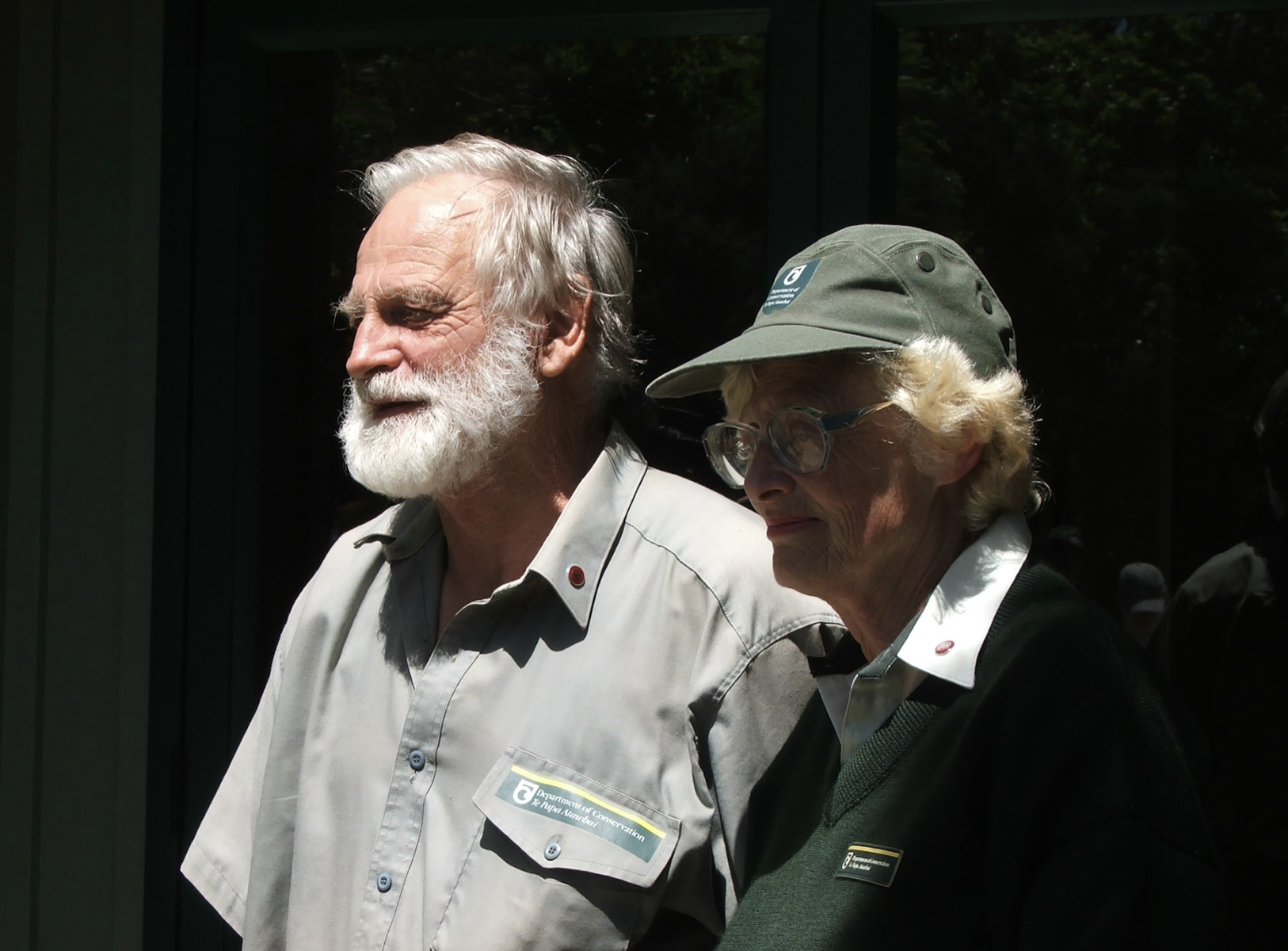
Ray and Barbara Walter
Credit: Neil Davies
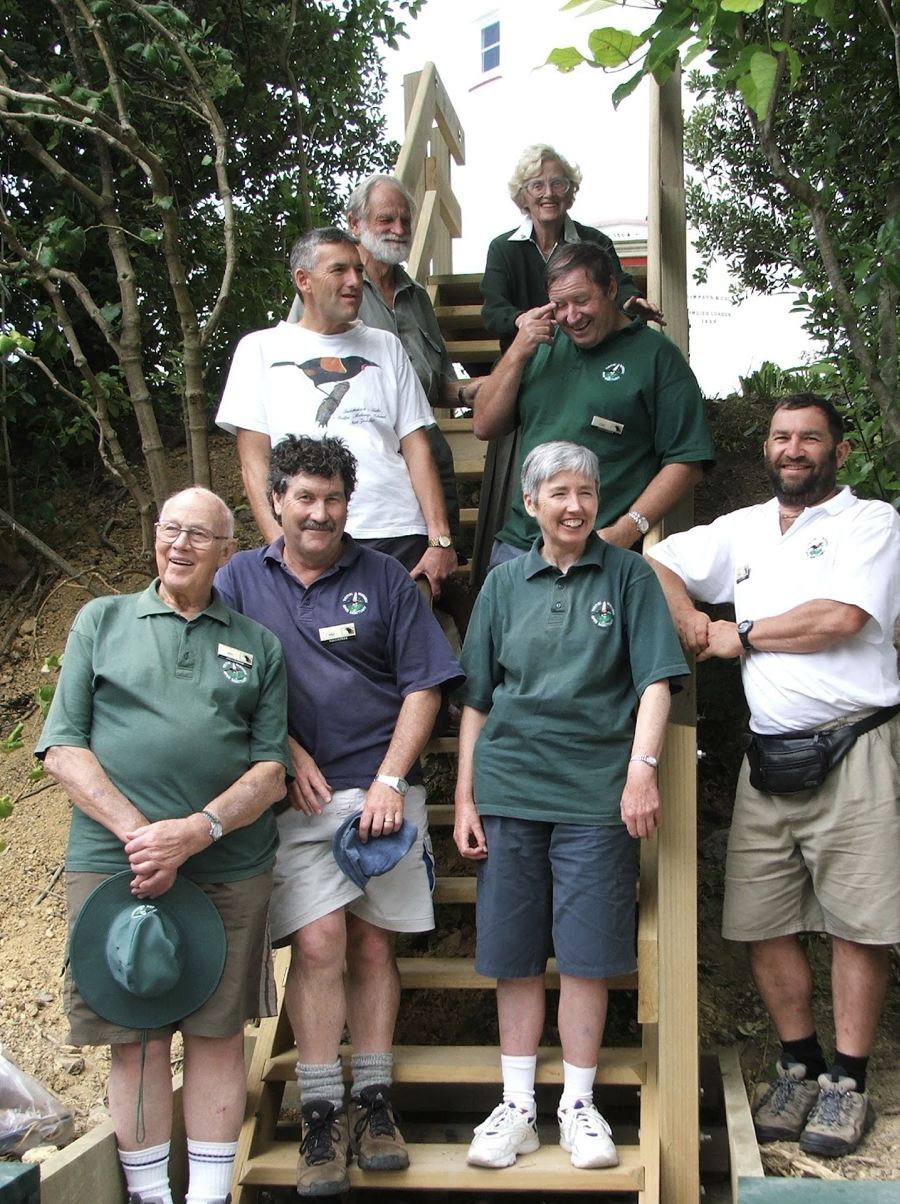
The Visitors Centre opening brought together six of the past seven SoTM chairpersons and they posed for this photograph with Ray and Barbara Walter (top) on the new Lighthouse Sfairs. The chairpersons are (from left front), Jim Battersby, Mel Galbraith, Peter Lee, Dell Hood, Carl Hayson, and Simon Fordham. (Absent is Trevor Sampson)
Credit: Neil Davies
The Visitors Centre opening brought together six of the past seven SoTM chairpersons and they posed for this photograph with Ray and Barbara Walter (top) on the new Lighthouse Sfairs. The chairpersons are (from left front), Jim Battersby, Mel Galbraith, Peter Lee, Dell Hood, Carl Hayson, and Simon Fordham. (Absent is Trevor Sampson)
Credit: Neil Davies
E-Bikes and Solar Power
E-Bikes and Solar Power: How DOC and Volunteers Are Cutting Carbon on Tiritiri Matangi
E-Bikes and Solar Power: How DOC and Volunteers Are Cutting Carbon on Tiritiri Matangi
Photo credit: Janet Petricevich
The Department of Conservation (DOC) is taking meaningful steps toward a greener future, starting with two wheels and the sun.
As part of its mission to reduce carbon emissions and model sustainable practices, DOC has added two electric bikes to the transport fleet on Tiritiri Matangi Island. One is a cargo e-bike, perfect for transporting gear and tools, while the other is a standard e-bike used by rangers and Supporters of Tiritiri Matangi (SoTM) volunteers to move around the island efficiently, no petrol required..
The e-bikes are powered by solar energy. Tiritiri Matangi Island is equipped with solar panels that generate electricity for island operations. That means these e-bikes are not only replacing vehicle trips but are being charged with 100% renewable energy.
A Solar-Powered Island
Tiritiri Matangi is no stranger to solar energy. The iconic Tiritiri Matangi lighthouse, New Zealand’s oldest operating lighthouse still in use, has been fully automated and solar-powered since 1990. Its solar panels charge batteries that power the lighthouse’s light assembly. In 2002, the original system was upgraded to a modern rotating beacon, further improving its reliability and efficiency.
Together, the solar-powered lighthouse and electric bikes reflect the island’s commitment to sustainable, low-impact operations, showing that even remote, heritage-rich places can lead the way in renewable energy use.

Simon Fordham using ‘Mo’ to deliver new tititipounamu/rifleman nest boxes prior to the start of the breeding season.
Why E-Bikes?
Electric bikes are a smart alternative to traditional fuel-powered vehicles, especially on a conservation island where minimising environmental impact is crucial.
- No direct emissions – E-bikes don’t burn fossil fuels.
- Energy efficient – They use far less energy than cars or quad bikes.
- Quiet operation – Great for keeping the peace in sensitive wildlife habitats.
- Eco-friendly access – They leave a much smaller footprint, literally and figuratively.
The cargo e-bike, in particular, helps with transporting essential gear, whether it’s tools for track maintenance or resources for the biodiversity team.
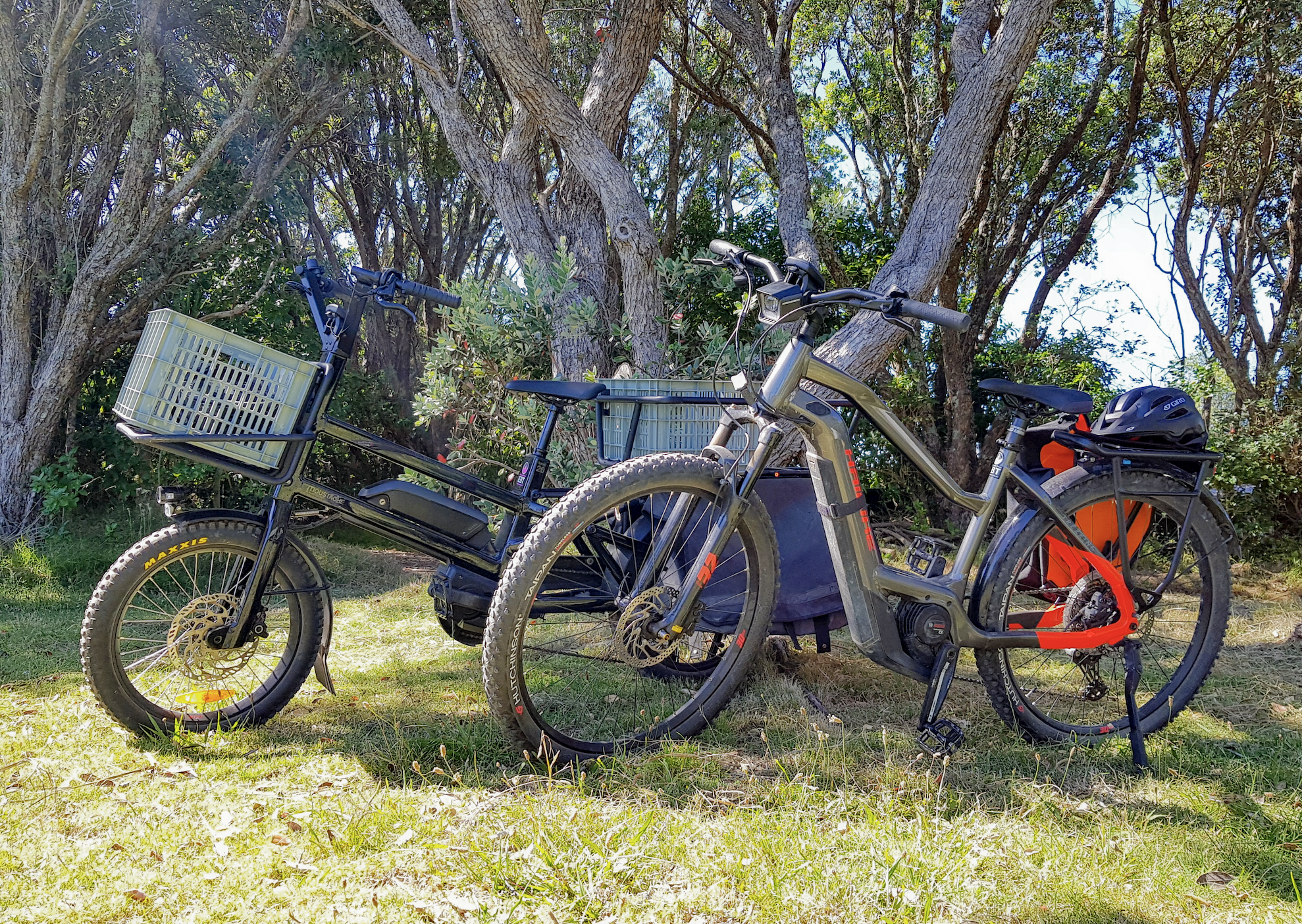
Fifty years since the translocation of kākāriki/ red-crowned parakeet
Fifty years since the translocation of kākāriki/ red-crowned parakeet
Fifty years since the translocation of kākāriki/ red-crowned parakeet
Author: Dick Veitch New Zealand ecologist and ornithologist
From the Supporters of Tiritiri Matangi Archives: Dawn Chorus, 138, August 2024
Header photo credit: Geoff Beals
To celebrate this milestone, we asked Dick Veitch, who was involved in the translocation, to share his memories of that time.
Visitors to this island haven have now seen kākāriki as they surely were over mainland New Zealand before the arrival of humans and their accompanying pests.
On Te Hauturu-o-Toi / Little Barrier Island, kākāriki survived with cats and kiore as predators. On the Hen and Chicken Islands, they survived with only kiore as a predator. On Macauley Island, they survived with goats and kiore and no trees, but on nearby forested Raoul Island, they were eradicated by a combination of goats, cats, and two rat species. When the goats were eradicated, kākāriki were again present in the forest, but we doubt that they were breeding. When the cats and rats were also removed, kākāriki were again abundant birds in the forest.
Like so many of our birds, kākāriki have two basic needs to overcome when faced with predation and competition: food and nesting. One of their preferred feeding habits is to scavenge for fallen seeds among the leaf litter. In this, they compete with kiore, who also scavenge for seeds. Ground- feeding also makes them susceptible to predation by cats.
It seems they can survive both of these threats if there are no goats present to remove the forest understory and most of the leaf litter, thus making it easy for cats to hunt. It also seems that kākāriki can defend their nests against kiore, but not against larger rats.
That readily explains the absence of kākāriki from many islands, but not Tiritiri Matangi, which had only kiore and always had some forest. We presume kākāriki were present but have no proof of this as Tiritiri Matangi, like Cuvier and a few other islands, was not often visited by ornithologists.
By the late 1960s, staff in the Wildlife Service, later to become part of the Department of Conservation, were attempting to actively improve our offshore islands by removing goats, sheep and cats and returning missing bird species. Kākāriki were proposed for re-introduction to Tiritiri Matangi and Cuvier, but there was controversy over the source of birds to release. Some aviculturists, who had stocks of captive kākāriki, wanted their birds to be used. Others in the decision chain stalled, on the grounds that such aviary-bred birds were cross-breeding between red and yellow-crowned species. It was then determined that the kākāriki taken from Hen Island to Mount Bruce Native Bird Reserve was a pure strain and thus suitable for the purpose. In January 1974, a consignment of approximately 30 kākāriki was sent from Mt. Bruce to Auckland, for liberation on Cuvier Island. Chris Smuts-Kennedy, Wildlife Service, duly took them off by road to Whitianga but, when he got there, the boat was not in the harbour and the sea was too rough for others to venture out. The birds were taken to an aviary in Auckland for a few days of rest before being taken by Wally Sander, Chief Ranger, Hauraki Gulf Maritime Park, and Chris to Tiritiri Matangi and released.
As we had hoped, they established themselves on the Island. There was just one problem. A member of the public made an accusation, to the Wildlife Service at least, that the lighthouse keeper on Tiritiri Matangi was catching kākāriki and selling them. We could not establish any truth in this accusation and concluded it may have come from a miffed aviculturist.
Tree planting began on Tiritiri Matangi in 1984, and Mike Graham, with members of the Ornithological Society, started bird counts in 1987. By that time, the kākāriki population was well established and probably growing, as the island environment changed with time and the planting programme.
From 1990 to 1992, kākāriki comprised 4.9% of the birds counted on the ‘forest transects’. Kiore were removed from the Island in 1993. From 1996 to 1998, kākāriki comprised 7.3% of the birds counted on the same transects. This was a 177% increase in the number of kākāriki counted, but it appeared to be less of an increase than the general bird population on the Island. There was a noticeable abundance of korimako/bellbirds and tīeke/saddlebacks at the same time. For all these species, the big benefit was the removal of a food competitor.
I hope that kākāriki and all other birdlife on Tiritiri Matangi continue to be a joy for all to behold for a very long time to come.
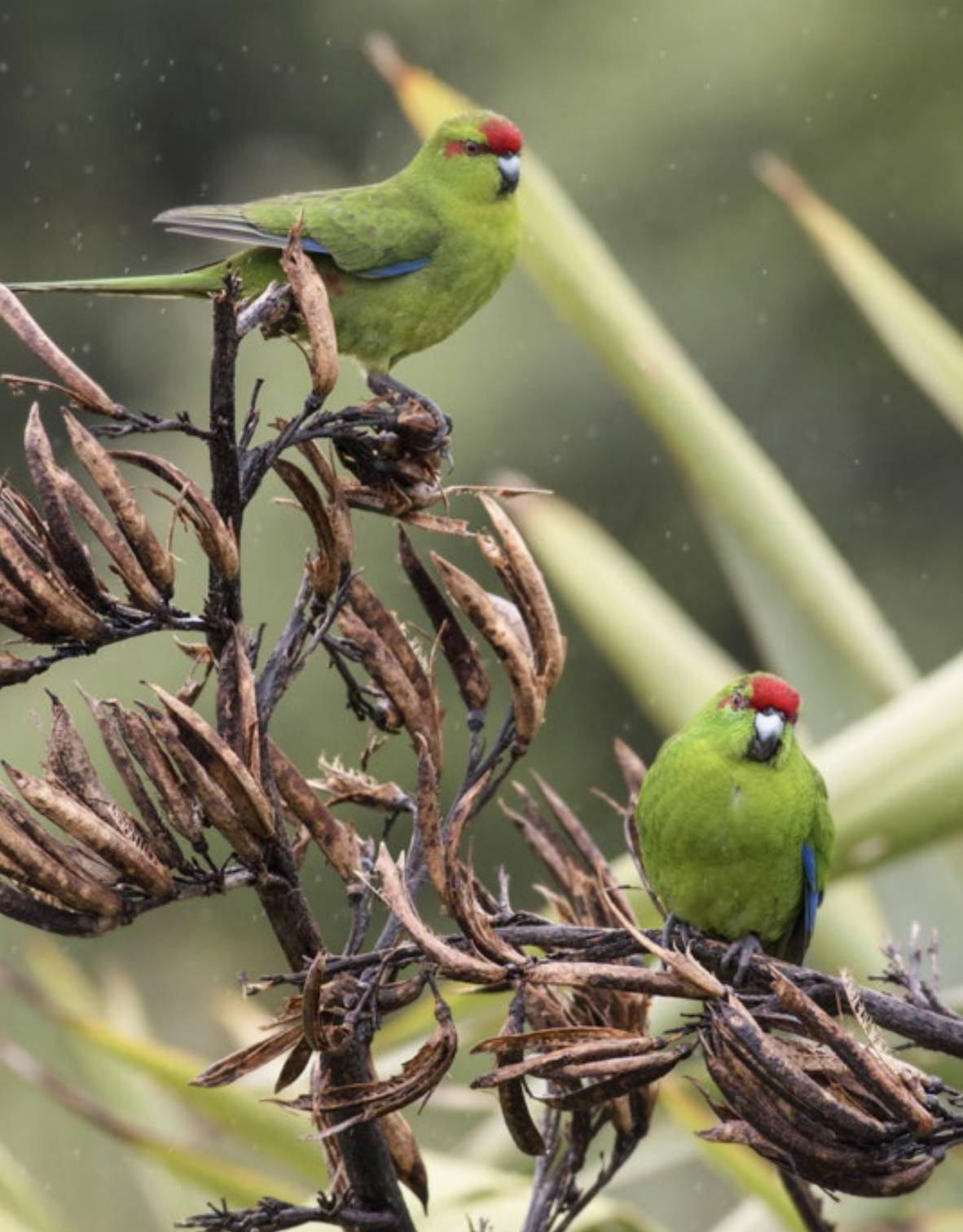
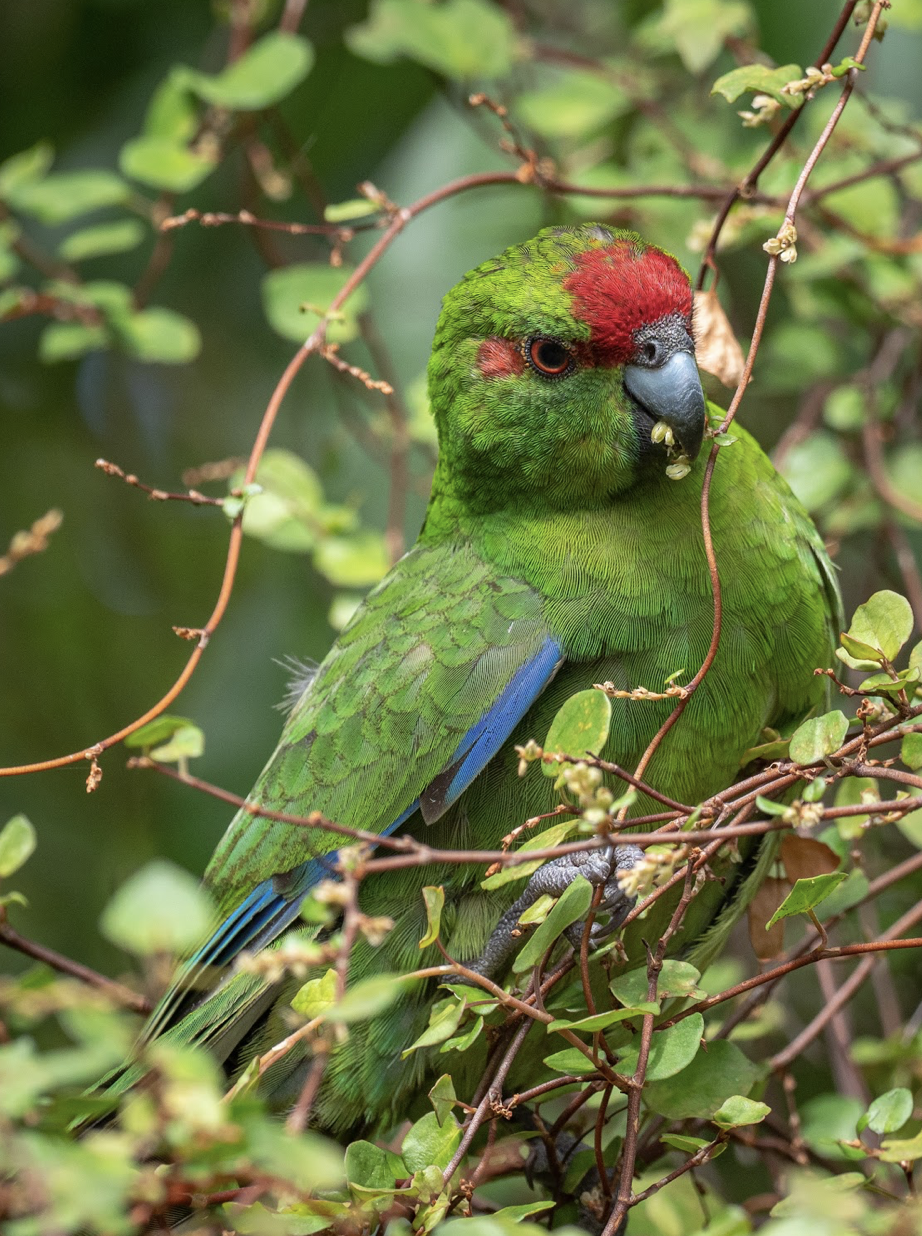
Left image: credit Hilda Mikaelsson
Right image: Jonathan Mower
Mammals (Part 3): Mammals in Pre-Human New Zealand
Mammals (Part 3): Mammals in Pre-Human New Zealand
Mammals (Part 3): Mammals in Pre-Human New Zealand
Author: Malcolm Pullan, Volunteer Guide
If you’re a New Zealander you will “know” that prior to the arrival of humans there were no mammals in New Zealand apart from bats. “Knowing” this is part of the DNA of being a New Zealander, like knowing that kiwi don’t fly and the All Blacks play rugby. However, if you had no connection with New Zealand whatsoever, and just so happened to have read Parts 1 and 2 of this series of articles on mammals, you wouldn’t be expecting that answer at all. You would be expecting me to say there are, or at least, were mammals in New Zealand (apart from bats) prior to the arrival of humans. And you would be perfectly right—and most New Zealanders perfectly wrong. New Zealand did indeed have mammals (other than bats) prior to the arrival of humans.
You don’t believe me? Not even if I say it with a smile? Let me try and convince you in other ways then…
Let’s summarise where we got to in the previous articles. Once upon a time New Zealand was joined to Australia and Antarctica. New Zealand began to separate from Australia/Antarctica about 105 MYA (million years ago) and continued to do so until sea completely separated them about 80 MYA, with the gap increasing substantially over the next 20+ million years. Globally, mammals evolved about 205 to 210 MYA. Mammals have been in Australia right from beginning of mammal-dom (1), starting with monotremes (i.e. mammals like the platypus and echidna), followed by some long since extinct lineages that I’ve informally called Allotheria (and whānau). Marsupials and placentals (the predominant mammalian lineages today, especially the latter) didn’t arrive in Australia until much later, almost certainly well after New Zealand separated from Australia. Monotremes and Allotheria (and whānau), on the other hand, were definitely in Australia when New Zealand and Australia were still joined. There is every reason to believe that New Zealand took some of these sorts of mammals with it when it broke away. Indeed, it would be very odd if it didn’t.
This is precisely why I have written parts 1 and 2 of this series. I could have easily written this present article without the others (now he tells me!). But if what’s being said here is going to bust a myth, then I’ve got some explaining to do about why busting the myth makes sense. I need to explain why it shouldn’t be a surprise that the myth is indeed a myth, i.e. it isn’t true.
I repeat. New Zealand did indeed have mammals (other than bats) prior to the arrival of humans. The evidence for this is actually quite simple and concrete (rock, to be precise). It is some mammalian fossil bones from about 16 to 19 MYA that were reported in a scientific paper in 2006 (2) This isn’t some obscure paper by some second-rate amateurs, but a mainstream article by Trevor Worthy (and team), one of the most respected professional palaeontologists working in the New Zealand field today. It is a bonafide and convincing result. Mammalian fossils dating from about 16 to 19 MYA have been found in New Zealand.
So what was this mammal like? For a start, it was very small. It was only about mouse-size. However that’s where the comparison with mice ends. Mice are placentals. This “not-a-mouse” (3) probably belonged somewhere in the now extinct group of lineages I have called Allotheria (and whānau) (4). Where in that group, though, is anybody’s guess. “Not-a-mouse” appears to be from a unique mammalian lineage that nobody knew about before. Not only that, as far as is currently known, all Allotheria (and whānau) lineages elsewhere in the world died out millions of years before “not-a-mouse” was alive. In other words, this New Zealand mammal was probably an ancient relict—a mammal of a type that had long since become extinct elsewhere. That New Zealand had such an ancient relict shouldn’t be a surprise. After all, this is precisely what the tuatara is in the reptile world.
It should also not be a surprise that “not-a-mouse” was a member of Allotheria (and whānau), rather than a marsupial or placental. According to Trevor Worthy and team, the most likely explanation for the existence of “not-a-mouse” is that it belonged to a population of mammals that had been in New Zealand continuously since it separated from Australia. Marsupials and placentals wouldn’t have been in this population because they weren’t in Australia at the time of separation.
So what happened to the mammals that were in New Zealand after it separated from Australia up until the time of “not-a-mouse”? Well, clearly they became extinct. (5) The next question is why? Why did they become extinct? One common explanation for pre-human extinctions in New Zealand is loss of habitat. New Zealand sank after it broke away from Australia and a lot of land disappeared into the sea. However the low point of this sinking was about 22 to 25 MYA. (6) “Not-a-mouse” comes from 16 to 19 MYA, so mammals clearly survived past this low point. Instead, the extinction of mammals in New Zealand was probably caused by global climate change. This isn’t the recent extremely rapid human-made global climate change, but a very much slower and more extensive change that occurred after 16 MYA (cooling in this case). (7)
Next question. Why has it taken so long for (non-bat) mammal fossils to appear in New Zealand? There is a fairly simple answer for this. New Zealand is very frustrating when it comes to fossils. While there are tons of very recent fossils (or pre-fossilised remains because they’re so recent) and tons of fossils of sea creatures, there are almost no older fossils of land animals at all. It is only relatively recently that a small patch with a decent selection of such fossils has been found, and then even more recently excavated and studied (with work still very much in progress—watch this space!). This patch is near St Bathans in Otago. “Not-a-mouse” was found here.
In summary then, New Zealand almost certainly had mammals when it broke away from Australia. In fact New Zealand has almost certainly had non-bat mammals for most of the time since then. The sole non-bat mammal that has been discovered so far was small and probably belonged to a lineage totally distinct from the modern successful mammalian lineages that rule the world today. Not only that, it survived in New Zealand long after any remotely similar mammals remained elsewhere in the world (like the tuatara in the reptile world). It became extinct sometime after about 16 MYA, probably because of global cooling. Mammalian fossils have only just been found because New Zealand has an extremely poor fossil record of land animals, apart from the very recent past. While these conclusions may well bust a New Zealand myth, there is nothing unexpected about the results from a rational point of view. They are completely in keeping with, and to be expected from wider global stories of geology and evolution.
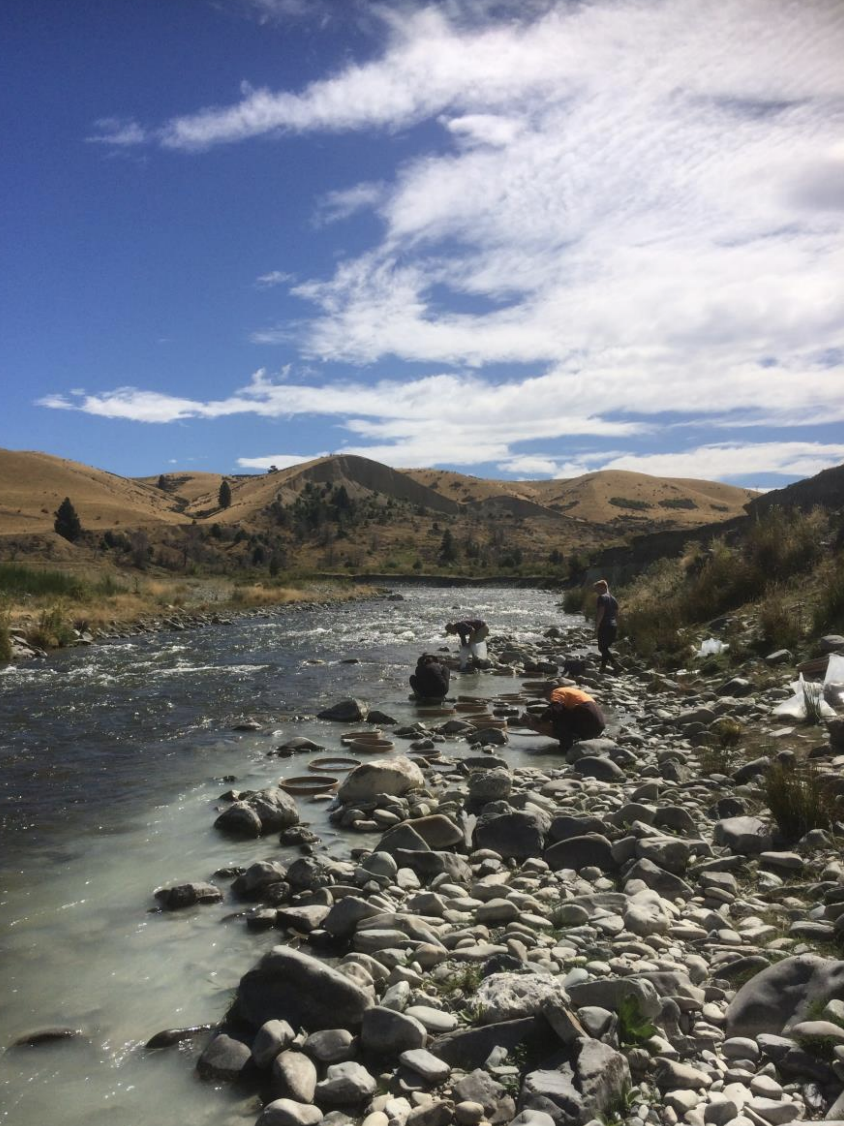
Figure 1: Palaeontologists excavating in the region where the mammal fossil was found (near St Bathans in Otago)
One final musing before I let you go. If, as seems likely, “not-a-mouse” was descended from mammals that were in New Zealand when it broke away from Australia, then many of our New Zealand birds will have evolved in the presence of mammals e.g. moa, kiwi, New Zealand wrens (e.g. rifleman) and the New Zealand wattle birds (e.g. kōkako). (8) How does this fit into the argument—and indeed much practical observation—that New Zealand birds don’t cope well with mammals? In the first place, the ancient New Zealand birds would have initially evolved alongside the New Zealand mammals. They had plenty of time to get used to each other, unlike contemporary New Zealand birds and recent placental arrivals. In the second place, if global cooling is the culprit in causing the extinction of New Zealand’s non-bat mammals, then it’s most likely they became extinct several million years ago, rather than comparatively recently. This will have given New Zealand birds plenty of time to forget about mammals altogether. Thirdly, the sort of mammals that New Zealand birds don’t cope at all well with are killing machines like rats, stoats and cats, and to a lesser extent mammals like deer, possums and rabbits. These are all placentals. “Not-a-mouse” was totally different. It was survivor from the days when mammals were small and largely kept in check by pesky dinosaurs. Perhaps, like the tuatara, New Zealand mammals retained their ancient features and were never much of a threat to birds in the first place?
I started this series of articles on mammals with a statement that many of us guides say to our visitors when they arrive on Tiritiri Matangi in order to explain the unique flora and fauna they’re about to see: “New Zealand broke away from the rest of the world about 60 MYA before mammals evolved.” Having completely demolished that statement on three accounts, what should we say instead? How about, “New Zealand broke away from the rest of the world about 80 MYA before modern mammals like rats and stoats evolved with their ruthless efficiency at killing”? What do you think we should say? Suggestions on the back of a postcard please!
P.S. A video
If you want to see the fossils of “not-a-mouse”, the paper by Trevor Worthy and team has photos (which can’t be reproduced here for copyright reasons). Alternatively, check out this video from Te Papa (Museum of New Zealand): https://collections.tepapa.govt.nz/topic/2918. (Caution: you may be disappointed when you see the fossils—you have been warned!)
P.P.S. A word on bats
Bats, like birds, have wings, and so a watery ditch isn’t going to be as big an obstacle to cross as it is for other land mammals. So it’s not surprising New Zealand had bats prior to human arrival when it didn’t have any other placentals. New Zealand has two types of bats, long-tailed and short-tailed, represented by just two living species today. (9) The long-tailed bat is nothing special from an evolutionary point of view. It arrived in New Zealand about 2 MYA and has close relatives in Australia and surrounding islands (e.g. New Guinea and New Caledonia). The short-tailed bats are much more unique. In Part 2 of this series on mammals I mentioned an Australian bat fossil from about 26 MYA. Lo and behold this bat was a relative of New Zealand’s short-tailed bats, so it seems likely that the New Zealand short-tailed bats came from Australia at some point. Any Australian relatives, though, are long since extinct. The closest living relative of New Zealand’s short-tailed bats today are in South America, but it’s a very distant connection indeed. This would make sense, given that the Australian bats are thought to have originated in South America.
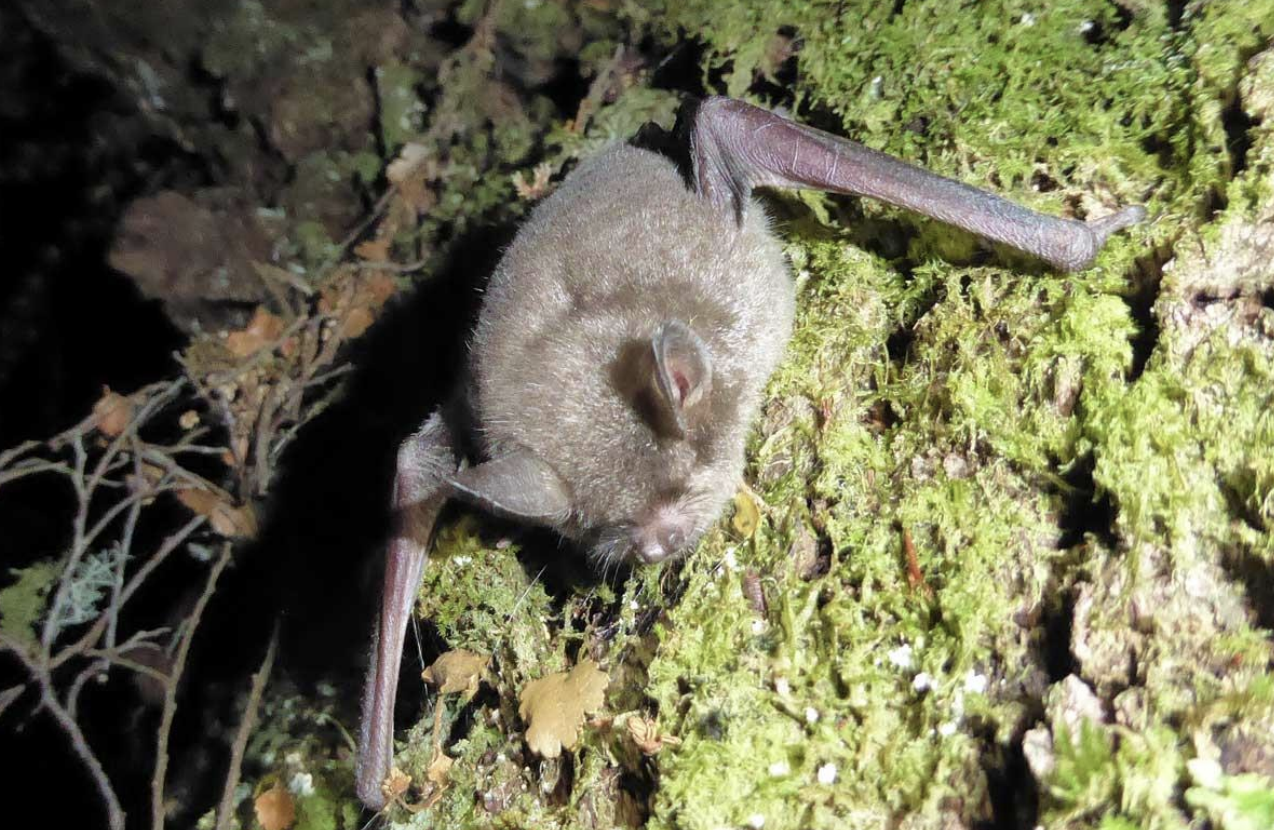
Figure 2: New Zealand short-tailed bat
Referencing:
1 My made-up word for the day. Will it go viral and make it into the Oxford Dictionary, I wonder?
2 Worthy, T.H., Tennyson, A.J.D. et al. (see references for more details).
3 There is still no formal name for this animal. Informal names in use include “St Bathans mammal” (after where it was found—see text) and “waddling mouse” (after the fact that its legs were probably somewhat out to the side like a crocodile’s rather than directly underneath like a real mouse).
4 I say “probably” because it can’t be completely ruled out that it isn’t a monotreme or therian (the lineage including marsupials and placentals). It just isn’t statistically very likely (which is as good as it often gets really when working out where different animals sit on the evolutionary tree of life).
5 Or did they? Ever since the days of Captain Cook there have been reports of a “New Zealand otter”, with the last claimed sighting being in 1973. However “no positive evidence exists, only fleeting glimpses, usually from trout fishers or duck shooters” (Gibbs, Ghosts of Gondwana, p. 27). Also, if it really did exist, “it is much more likely to have been an aquatic monotreme than an otter” (Gibbs, p. 27).
6 This is known as the Oligocene drowning. A few years ago there was intense debate about whether New Zealand disappeared completely under the sea at the low point, but it is now more or less certain that at least some land remained, albeit not very much.
7 This massive global cooling was largely caused by the separation of Antarctica from Australia and South America. This separation created the ocean current known as the Antarctic Circumpolar Current circulating the globe unobstructed in the southern polar region. When this current formed it put a stop to the mixing of the southern polar seas with warmer tropical ones that had been operating for millions of years. The Antarctic Circumpolar Current created the cold Antarctic that we know today.
8 But probably not more recent arrivals, e.g. takahē and tūī.
9 The long-tailed bat and the lesser short-tailed bat. There is possibly another short-tailed bat alive, the greater short-tailed bat, although the chances of it still being around are slim. It hasn’t been seen since 1967. See https://www.doc.govt.nz/nature/native-animals/bats-pekapeka/short-tailed-bat/.
References:
Gibbs, G. 2016. Ghost of Gondwana: The History of Life in New Zealand (revised edition). Potter &
Burton, Nelson. (pp. 27–28, 38–40, 83–86, 121–122, Chapter 10)
Lomolino, M.V., Riddle, B.R. & Whittaker, R.J. 2018. Biogeography: Biological Diversity across
Space and Time (5th ed.). Sinauer Associates, Sunderland, MA. (pp. 261–262)
Pough, F.H, Bemis, W.E, McGuire, B. & Janis, C.M. 2023. Vertebrate Life (11th ed.). Sinauer
Associates, New York. (p. 445)
Thomsen, T. 2021. The Lonely Islands: The evolutionary phenomenon that is New Zealand. Reed
New Holland Publishers. (pp. 94–96, 194–196, Chapter 8)
Worthy, T.H., Tennyson, A.J.D. et al. 2006. “Miocene mammal reveals a Mesozoic ghost lineage on
insular New Zealand, southwest Pacific”. Proceedings of the National Academy of Sciences of the
United States of America 103(51), pp. 19419–23. (This article can be downloaded here:
https://www.ncbi.nlm.nih.gov/pmc/articles/PMC1697831/pdf/zpq19419.pdf)
Picture credits:
• Figure 1: https://commons.wikimedia.org/wiki/File:Saint_Bathans_Miocene_Fossil_Site_NJR.jpg
(Wikipedia, shared through Creative Commons licensing).
• Figure 2: https://www.doc.govt.nz/nature/native-animals/bats-pekapeka/short-tailed-bat/
(Department of Conservation, shared through Creative Commons licensing).
Mammals (Part 2): Evolution of Mammals
Mammals (Part 2): Evolution of Mammals
Mammals (Part 2): Evolution of Mammals
Author: Malcolm Pullan, volunteer guide
Date: October 2024
According to a very unscientific survey carried out by examining my gut feeling, many people can answer the question, “When did mammals first appear?” Further similar unscientific analysis reveals that most of these answers will be something like, “About 60 MYA (million years ago), when dinosaurs became extinct”. Unfortunately, this common answer is incorrect (in fact, it’s not even true either…).
The purpose of this article is to put the record straight—and to give a little evolutionary history of mammals as whole, concluding with a little look at the evolutionary history of Australian mammals. The story of New Zealand mammals will follow on from this in final part of this series of articles.
Before beginning the discussion, I should warn you that the evolutionary history of mammals is an ever-changing minefield. There are controversies over dating and controversies of definitions and names of different groups of mammals, on top of which new information is popping up all the time to throw spanners in the works. Rather than trying to weigh up the recent academic literature myself (which is never really wise for a layperson), in what follows I will leave it to the experts (i.e. a well-respected and recent university-level textbook (1)).
With that proviso in mind, let’s begin at the beginning. When did mammals first appear? There are a range of figures out there. All of them, though, are way beyond 60 MYA. They’re actually in the region of about 205 to 225 MYA. Far from arising when dinosaurs became extinct (which, to be precise, occurred about 66 MYA)(2), it’s actually more accurate to say the opposite—that mammals and dinosaurs both appeared at similar times! (3)
The range of dates for the first appearance of mammals wafting around seem to be just as much a result of different definitions of mammals as anything else. I’m sure no-one reading this will want to get bogged down in semantics for the sake of a few million years, so I’m just going to take one of the common definitions of mammals—the group of animals known scientifically as Mammalia. This group first appeared about 205 to 210 MYA and is quite easy to define. It’s the common ancestor of all living mammals and all descendants of that common ancestor. In other words, it’s all living mammals, along with all those animals in the same family tree that have become extinct.
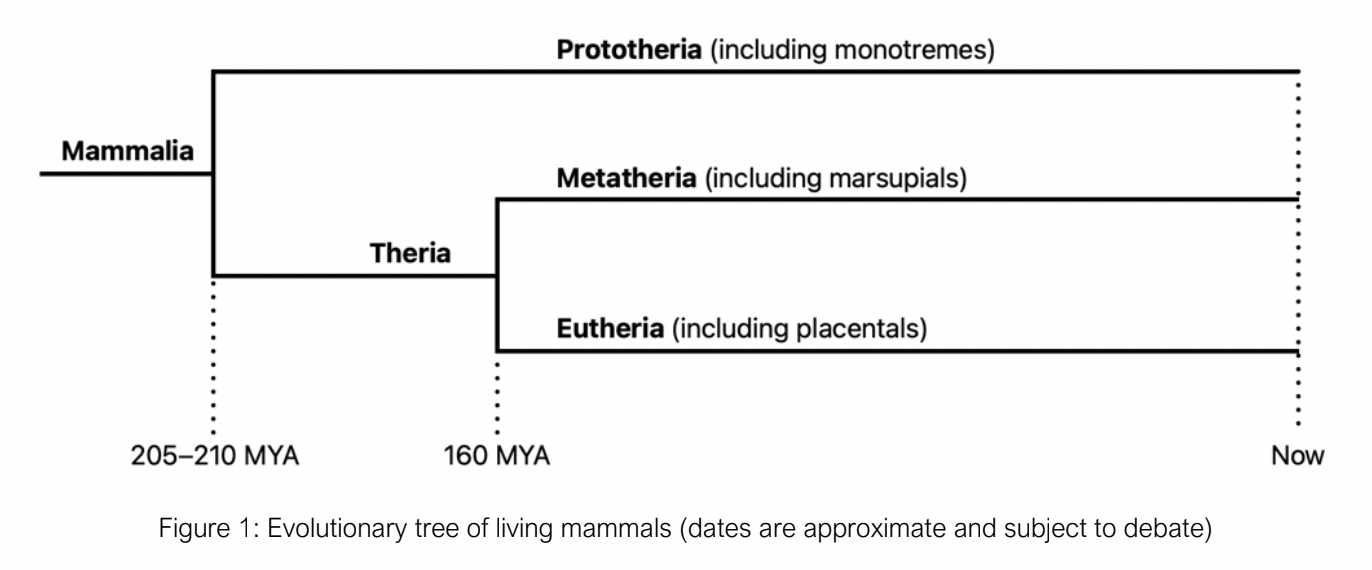
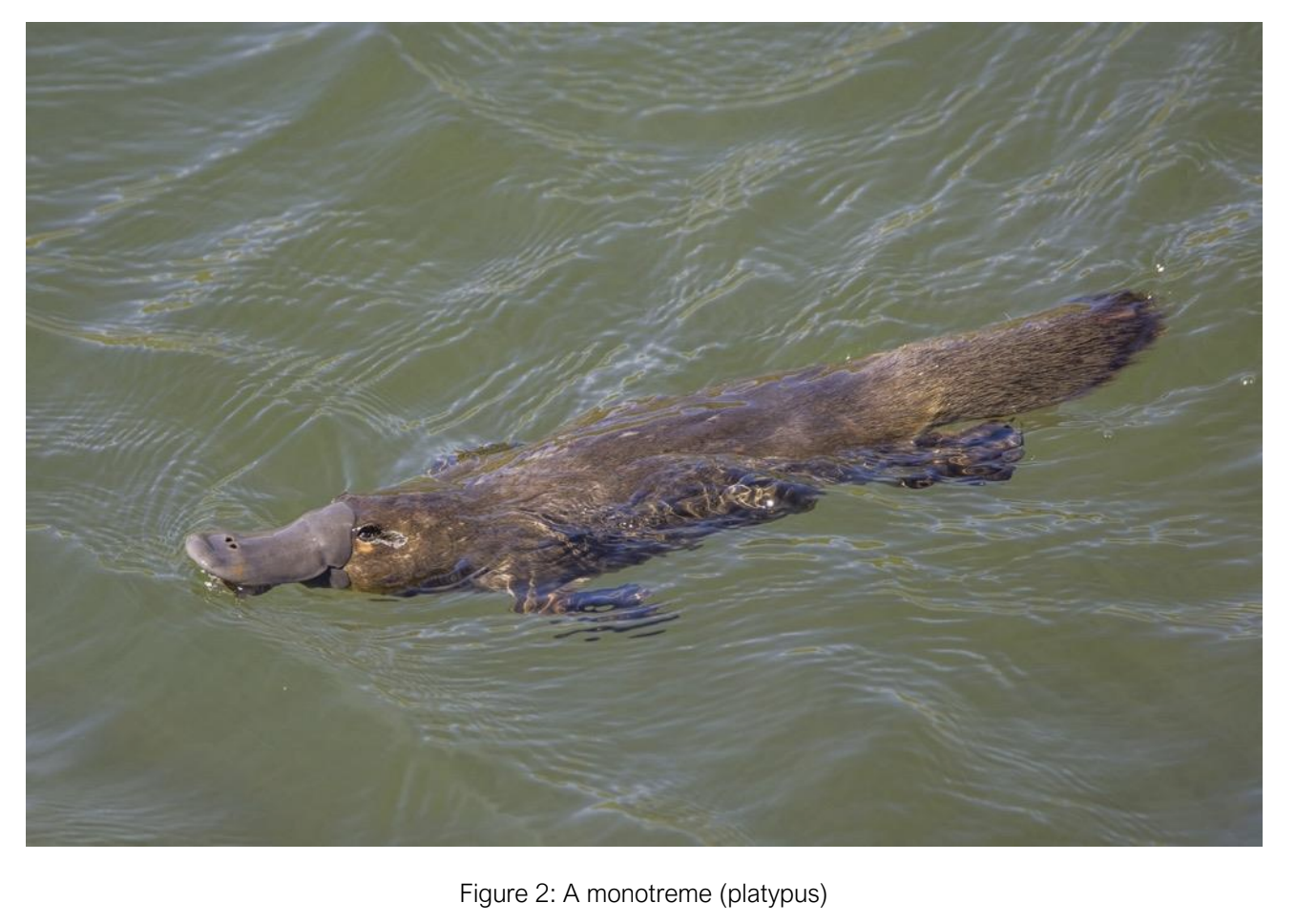
Figure 1 shows a basic evolutionary diagram for mammals (i.e. Mammalia). Living mammals fall into two main groups: Prototheria and Theria, with Theria being split further into Methatheria and Eutheria. The living members of each of these groups are:
- Prototheria: Monotremes (egg laying mammals), i.e. echidnas and the platypus (see Figure 2).
- Metatheria: Marsupials (mammals with pouches for young), e.g. kangaroos and koalas (see Figure 3).
- Eutheria: Placentals (4), i.e. all other living mammals, e.g. rats, cows, bears, dolphins, humans… (see Figure 4).
Although it goes without saying there is considerable debate about when each of these separate groups originated, it is generally agreed that they all predate the extinction of dinosaurs by at least several tens of millions of years (see Figure 1). So where did this common misperception about mammals only evolving after the extinction of dinosaurs come from? Well, it arose because of what happened after the dinosaurs became extinct. When dinosaurs were around, they ruled the world. There were big ones and small ones, occupying all manner of niches. This would have made it pretty difficult for any other animal to find a place to live—except… Dinosaurs were mostly daytime creatures. The night-time was generally free of those pesky dinosaurs, especially if you were going to be very small and crawl around quickly. So that’s what early mammals did. They were generally small nocturnal, shrew-like creatures (see Figure 5)(5). Even by the time dinosaurs became extinct, mammals hadn’t become any bigger than the size of a badger (6). But when the dinosaurs did become extinct… It was party time! Suddenly there were loads of free niches, especially in the daytime. Although many mammals also died off with the dinosaurs (7), there were still plenty around to party. Those that remained quickly evolved to exploit the new niches left by the dinosaurs. Having said that, some mammals were better party animals than others. Monotremes stayed in their own quiet corner and carried on much as before. They’ve never amounted to much. Metatherians (marsupials) had a bit of a party. But it was the eutherians (placentals) who were the real party animals. Placentals really took off after the extinction of the dinosaurs and diversified into many different groups. And this is where the idea that mammals only evolved after the extinction of dinosaurs comes from. It was only after the extinction of the dinosaurs that mammals (i.e. placentals) really began to take on the shape, size and forms that we are familiar with today. It was only once the dinosaurs disappeared that mammals (i.e. placentals) could rise to rule the world as they do today.

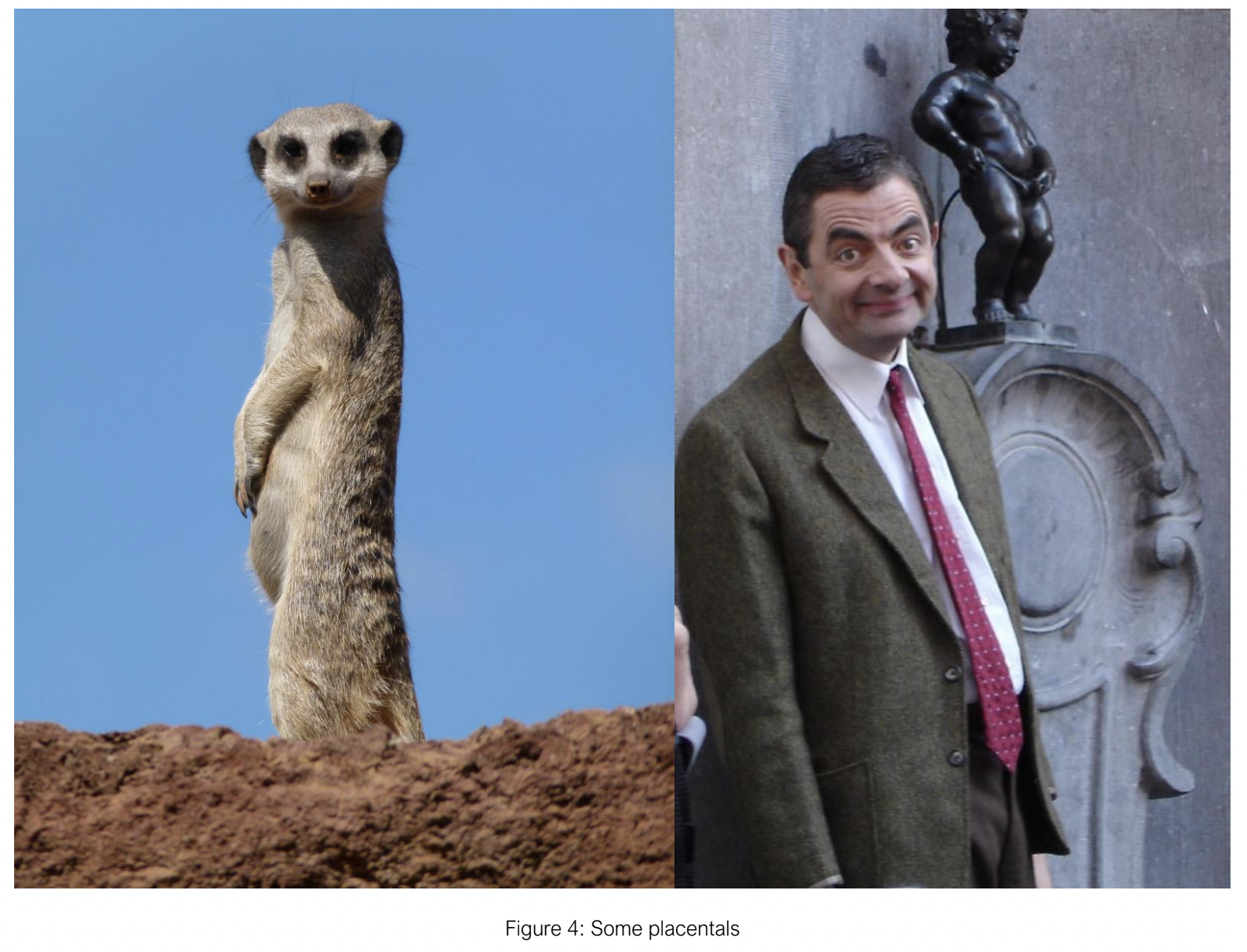
So that’s the evolutionary story of mammals living today in (very) brief. In order to talk about New Zealand’s past though, there’s a bit missing. Once upon a time there was a successful and wide-spread mammalian lineage sitting between Prototheria and Theria called Allotheria (see Figures 6 and 7). This lineage suffered badly in the mass extinction event that killed off the dinosaurs. The remaining allotherians managed to party a bit afterwards, but in the end they were probably outcompeted by placentals, and they became extinct by about 30 to 35 MYA. But that’s not all. Allotheria wasn’t the only mammalian lineage sitting between Prototheria and Theria. There were, in fact, many more mammalian lineages sitting between the two that have long since become extinct (imagine a diagram like Figure 6, but with lots of branches in it). It’s just that Allotheria is probably the most well-known. Since I’m not being particularly formal, I’m going to call all the lineages between Prototheria and Theria, “Allotheria (and whānau)”. (Please don’t tell any evolutionary biologist I’ve just written that.)(8)
In summary, mammals have been around for hundreds of millions of years. Up until the extinction of the dinosaurs most were very small, and none were big. Mammals divided into the extant groups prototherians (including monotremes), metatherians (including marsupials) and eutherians (including placentals) long before the extinction of the dinosaurs. After dinosaurs became extinct one group in particular took off, diversified and took over—and that is the placentals. Prior to the extinction of the dinosaurs there were also many other mammalian lineages as well (which I’m calling “Allotheria (and whānau)”), some of which were quite successful in their time. However they have long since become extinct.
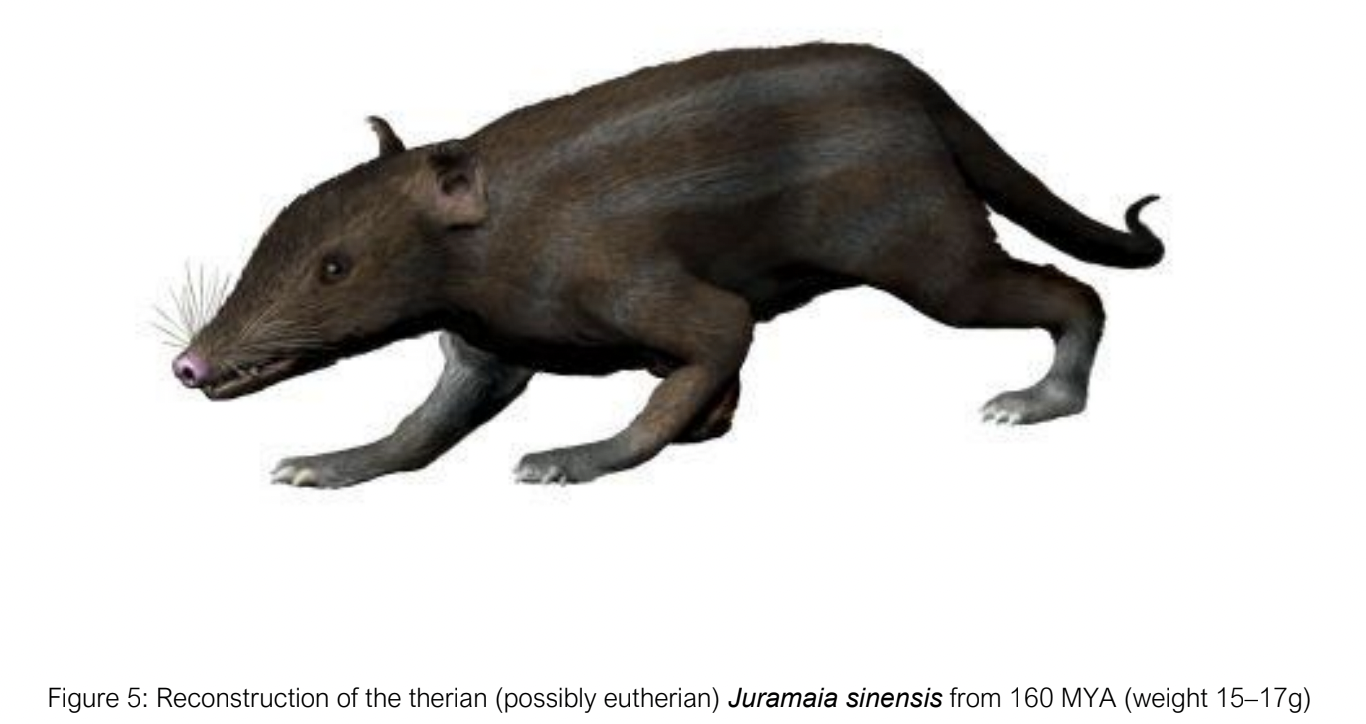
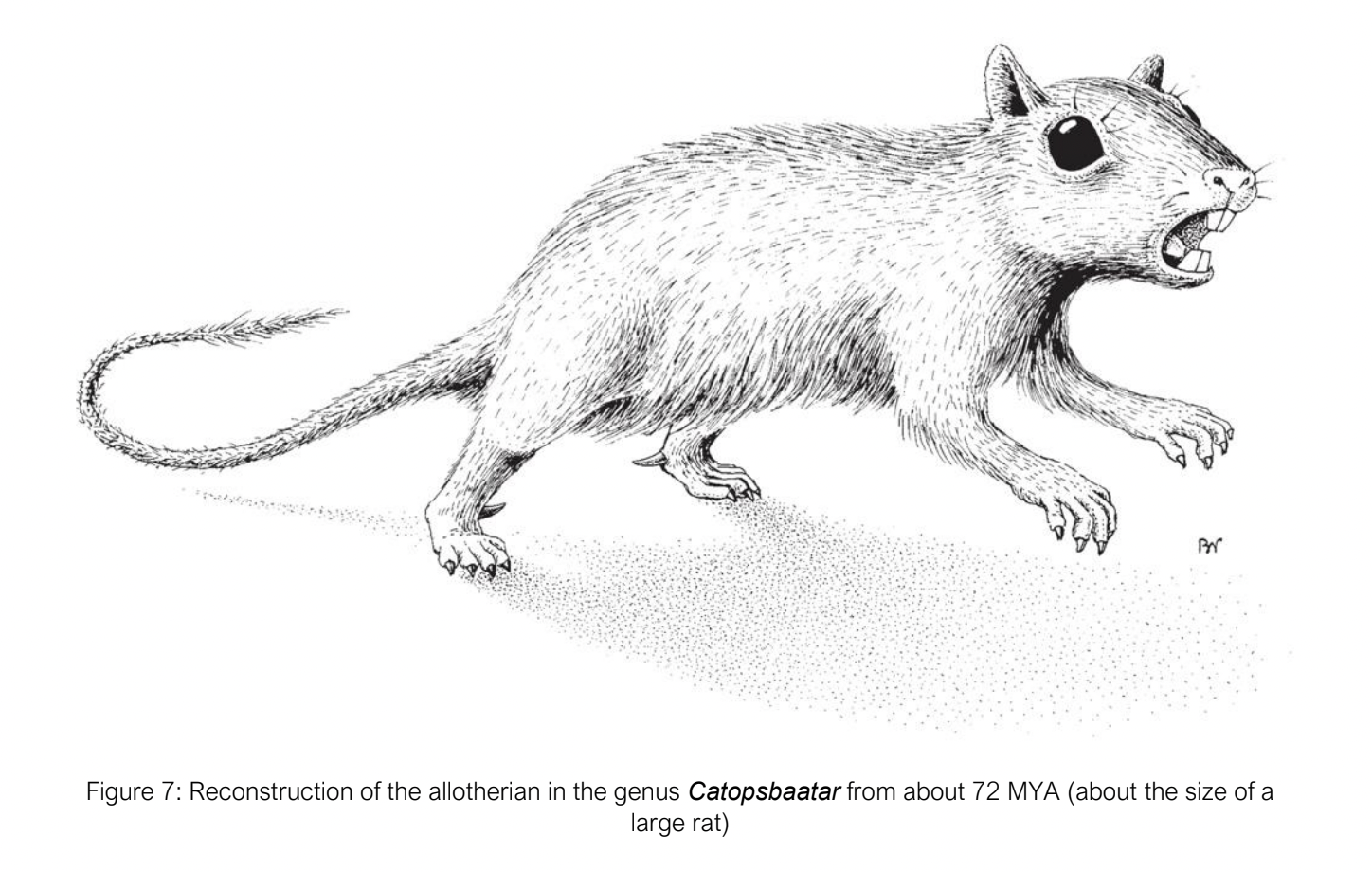
Mammals in Australia
With that global picture in place, let’s have a quick look at the story of mammals in Australia. As noted already, this will give the background for the New Zealand story in the next article. The Australian story can be summarised under the headings of the main mammalian groups.
- Prototheria (monotremes): These originated in the Australian region a very long time ago and have always been there.
- Allotheria (and whānau): There are a couple of fossils of these in Australia from about 120 MYA.
- Metatheria (marsupials): This one is interesting, because, although Australia is known for its marsupials, Australia is not where they originated. The oldest marsupial fossils are actually from North America. However it was in South America where marsupials first took off properly. From there they made their way to Australia. The earliest marsupial fossils in Australia are from about 55 MYA. How did marsupials get to Australia, you may well ask? As seen in Part One of this series of articles, at 55 MYA Australia was joined to Antarctica. What wasn’t shown in Part One was that at the time Antarctica was also joined at the tip to South America, or at least almost so. It seems, then, that sometime around 55 MYA marsupials travelled from South America, to Antarctica and then on to Australia (Antarctica was much warmer then and covered in forests).(9)
- Eutheria (placentals): There is single fossil in Australia from about 55 MYA that many claim is a placental. However this is not definitive. Definitive placental fossils don’t appear in Australia until much later. There is a fossil of a bat from 26 MYA. As with the marsupials, these bats probably originated in South America. When it comes to non-flying mammals in Australia, the first definitive placental fossils are from around only 4.5 MYA. These (rodents) originated from South East Asia. The reason it took so long for these mammals to get to Australia is that Australia and South East Asia used to be a long way apart. The two moved closer together over a period of millions of years, and it would seem it is only in the recent geological past that the two have been close enough for animals to jump from one to the other.
And that’s the Australian story. If you’ve made it up to this point, you might be putting two and two together and feeling somewhat perplexed. Why on earth aren’t there any native (non-flying) mammals in New Zealand? If mammals have been around for 200 or so million years, and they were in Australia when New Zealand was still part of Australia, why weren’t they in New Zealand when it broke away? Or perhaps they were? If so, whatever happened to them?
Tune in next time for the final episode of the story of mammals in New Zealand.
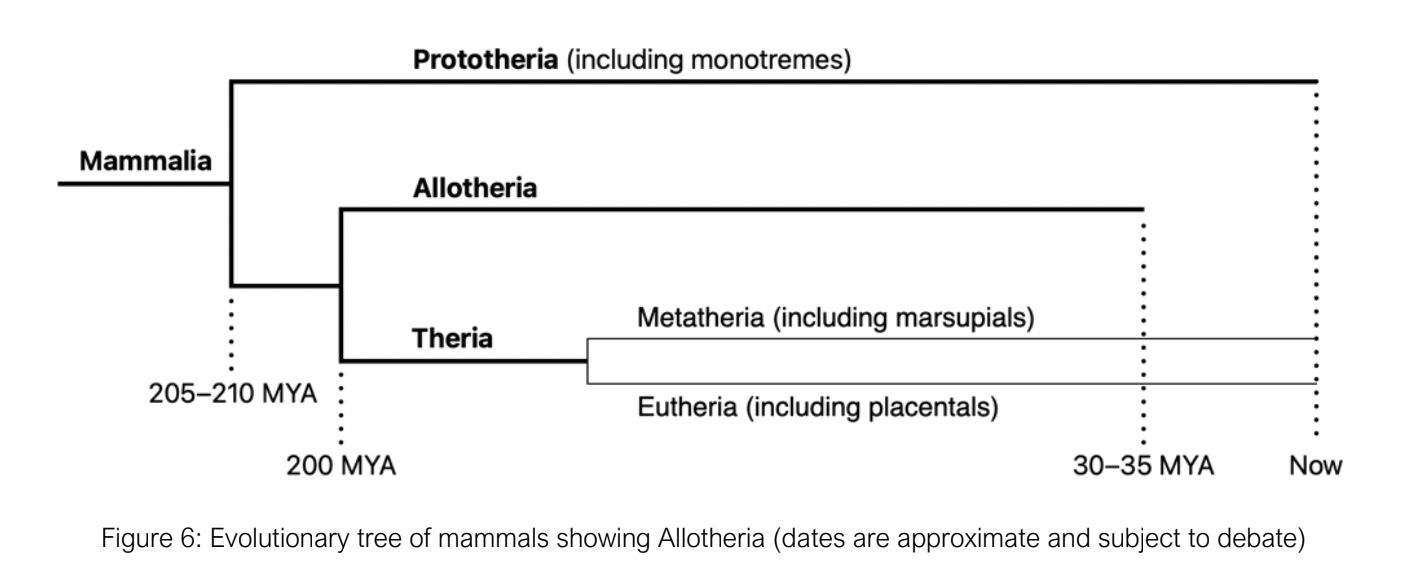
Footnotes:
- Vertebrate Life (11th edition) by Pough et al.
- And to be further precise, we’re talking here about non-avian dinosaurs, i.e. dinosaurs that are not birds. Birds are actually dinosaurs, although most people aren’t aware of that. But that’s a story for another article…
- Dinosaurs first appeared about 230 to 245 MYA.
- As the name suggests, during gestation placentals attach to the mother via a placenta. However, marsupials also have placentas. What is different is that a marsupial placenta is generally less well-developed than a placental’s. A marsupial also has a very short gestation period and its placenta is only present for about 20% of that time. Conversely, a placental has a comparatively long gestation time and the placenta is present for most of it.
- This explains the exceptional sense of smell and hearing most mammals have today (humans, and related primates, have a very poor sense of smell compared with most mammals), not to mention good night vision. Incidentally, even today most mammals are small and nocturnal.
- This was Repenomamus giganticus from about 125 MYA.
- There has been much debate about what caused this general mass extinction. There is no doubt an asteroid hit the earth 66 MYA and caused major devastation. Did this cause the mass extinction? The best answer is probably that it was the final straw in a period in earth’s history when life as a whole was under considerable strain. This strain was possibly caused by prolonged and intense volcanic activity.
- Who made that label bold?
- Incidentally, monotreme fossils have been found in South America, so there was clearly two-way traffic of mammals between South America and Australia via Antarctica. Also incidentally, before humans arrived in Australia about 40,000 to 50,000 years ago there were many more species of marsupials there than there are now, including marsupial lions and giant kangaroos.
References:
Gibbs, G. 2016. Ghost of Gondwana: The History of Life in New Zealand (revised edition). Potter & Burton, Nelson. (pp. 72–74)
Lomolino, M.V., Riddle, B.R. & Whittaker, R.J. 2018. Biogeography: Biological Diversity across Space and Time (5th ed.). Sinauer Associates, Sunderland, MA. (pp. 247–249)
Pough, F.H, Bemis, W.E, McGuire, B. & Janis, C.M. 2023. Vertebrate Life (11th ed.). Sinauer Associates, New York. (p. 233–234, Chapters 22 & 23)
Thomsen, T. 2021. The Lonely Islands: The evolutionary phenomenon that is New Zealand. Reed New Holland Publishers. (pp. 94–96, 194–196)
Picture credits:
- Figure 1: My own work, after Figures 22.1 and 23.2 in Vertebrate Life (11th edition) by Pough et al.
- Figure 2: https://upload.wikimedia.org/wikipedia/commons/1/1a/Duck-billed_platypus_%28Ornithorhynchus_anatinus%29_Scottsdale.jpg (Wikipedia, shared through Creative Commons licensing).
- Figure 3: https://upload.wikimedia.org/wikipedia/commons/4/49/Koala_climbing_tree.jpg (Wikipedia, shared through Creative Commons licensing).
- Figure 4: https://upload.wikimedia.org/wikipedia/commons/e/e4/Suricata_suricatta_-_meerkat_-_suracte_-_Erdm%C3%A4nnchen_07.jpg and https://upload.wikimedia.org/wikipedia/commons/6/6f/Rowan_Atkinson_and_Manneken_Pis.jpg (Wikipedia, shared through Creative Commons licensing).
- Figure 5: https://en.wikipedia.org/wiki/Juramaia#/media/File:Juramaia_NT.jpg (Wikipedia, shared through Creative Commons licensing).
- Figure 6: My own work, after Figure 22.1 in Vertebrate Life (11th edition) by Pough et al.
- Figure 7: https://upload.wikimedia.org/wikipedia/commons/4/4c/Catopsbaatar.jpg (Wikipedia, shared through Creative Commons licensing).
